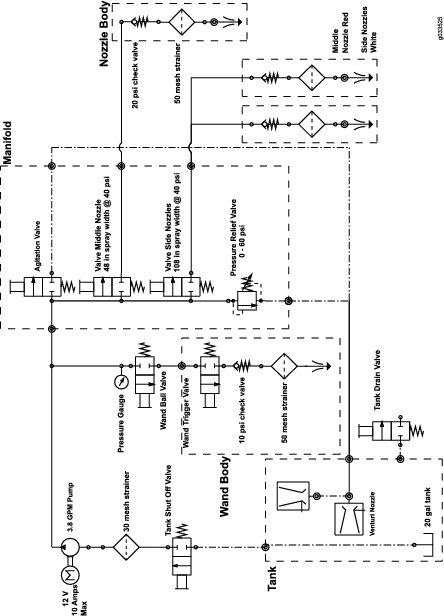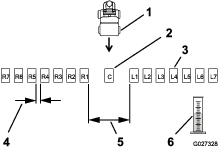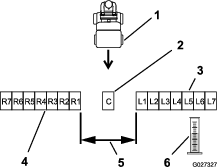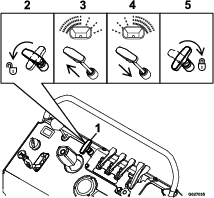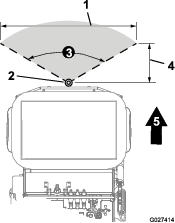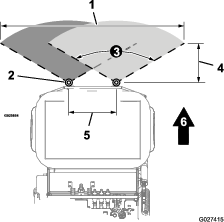| Maintenance Service Interval | Maintenance Procedure |
|---|---|
| Before each use or daily |
|
Introduction
This stand-on spreader sprayer is intended for use by trained operators in residential and commercial applications. The machine is primarily designed for chemical distribution used for turf care or snow/ice removal at residential grounds, parks, sports fields, and on commercial grounds.
Read this information carefully to learn how to operate and maintain your product properly and to avoid injury and product damage. You are responsible for operating the product properly and safely.
You may contact Toro directly at www.Toro.com for product safety and operation training materials, accessory information, help finding a dealer, or to register your product.
Whenever you need service, genuine Toro parts, or additional information, contact an Authorized Service Dealer or Toro Customer Service and have the model and serial numbers of your product ready. Figure 1 identifies the location of the model and serial numbers on the product. Write the numbers in the space provided.
Important: With your mobile device, you can scan the QR code on the serial number decal (if equipped) to access warranty, parts, and other product information.
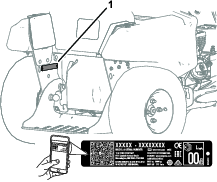
This manual identifies potential hazards and has safety messages identified by the safety-alert symbol (Figure 2), which signals a hazard that may cause serious injury or death if you do not follow the recommended precautions.

This manual uses 2 words to highlight information. Important calls attention to special mechanical information and Note emphasizes general information worthy of special attention.
It is a violation of California Public Resource Code Section 4442 or 4443 to use or operate the engine on any forest-covered, brush-covered, or grass-covered land unless the engine is equipped with a spark arrester, as defined in Section 4442, maintained in effective working order or the engine is constructed, equipped, and maintained for the prevention of fire.
The enclosed engine owner's manual is supplied for information regarding the US Environmental Protection Agency (EPA) and the California Emission Control Regulation of emission systems, maintenance, and warranty. Replacements may be ordered through the engine manufacturer.
Warning
CALIFORNIA
Proposition 65 Warning
The engine exhaust from this product contains chemicals known to the State of California to cause cancer, birth defects, or other reproductive harm.
Battery posts, terminals, and related accessories contain lead and lead compounds, chemicals known to the State of California to cause cancer and reproductive harm. Wash hands after handling.
Use of this product may cause exposure to chemicals known to the State of California to cause cancer, birth defects, or other reproductive harm.
Safety
The following instructions are from ANSI standard B71.4-2017.
General Safety
This product is capable of causing personal injury. Always follow all safety instructions to avoid serious personal injury.
Using this product for purposes other than its intended use could prove dangerous to you and bystanders.
-
Read and understand the contents of this Operator’s Manual before starting the engine.
-
Use appropriate personal protective equipment (PPE) to guard against contact with chemicals. Chemical substances used in the sprayer system may be hazardous and toxic.
-
Do not put your hands or feet near moving components of the machine.
-
Do not operate the machine without all guards and other safety protective devices in place and working on the machine.
-
Keep clear of any discharge area of the sprayer nozzles and spray drift. Keep bystanders and pets a safe distance away from the machine.
-
Keep children out of the operating area. Never allow children to operate the machine.
-
Stop the machine, shut off the engine, and remove the key before filling, emptying, servicing, or unclogging the machine.
Improperly using or maintaining this machine can result in injury.
To reduce the potential for injury, comply with these safety instructions
and always pay attention to the safety-alert symbol  , which means Caution, Warning,
or Danger—personal safety instruction. Failure to comply with
these instructions may result in personal injury or death.
, which means Caution, Warning,
or Danger—personal safety instruction. Failure to comply with
these instructions may result in personal injury or death.
You can find additional safety information where needed throughout this manual.
Also, go to www.Toro.com for even more safe operating practices, including safety tips and training materials.
Not all the attachments that adapt to this machine are covered in this manual. Refer to the operator’s manual provided with each attachment for additional safety instructions.
Safety and Instructional Decals
 |
Safety decals and instructions are easily visible to the operator and are located near any area of potential danger. Replace any decal that is damaged or missing. |


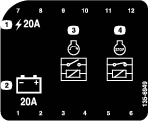



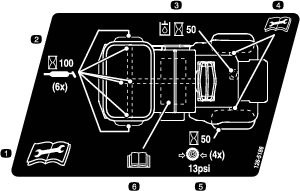
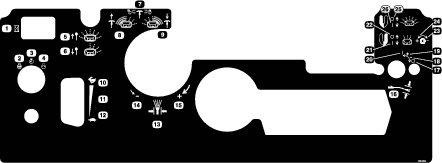
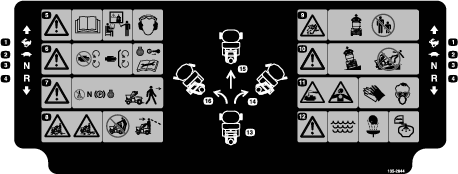
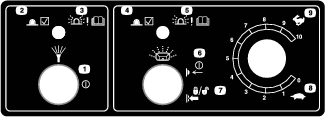
Setup
Checking the Tire Air Pressure
Check the air pressure in the front and rear tires, and if necessary, add air to the appropriate pressure; refer to Checking the Air Pressure in the Tires.
Checking the Engine-Oil Level
The engine comes with oil; check the engine-oil level and, if necessary, add to the appropriate level; refer to Engine Oil Specification and Checking the Engine-Oil Level.
Checking the Transaxle-Fluid Level
The transaxle comes with fluid; check transaxle-fluid level in the expansion tank, and if necessary, add to the appropriate level; refer to Servicing the Transaxle.
Connecting the Battery
-
Remove the battery cover from the battery box (Figure 3).

-
Install the positive-battery cable to the positive (+) battery terminal with a flanged bolt and flanged nut (Figure 3).
-
Install the negative-battery cable to the negative (–) battery terminal with a flanged bolt and flanged nut (Figure 3).
-
Install the cover on the battery box and secure the cover and box to the battery tray with the battery strap (Figure 3).
Product Overview


Machine Controls
Steering Control
The steering control is located behind the control console (see Figure 6).
-
Move the steering control to the right or left to steer the machine to the right or left respectively.
-
Moving the steering control to the center allows the machine to steer straight.
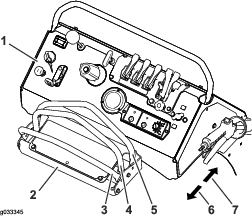
Motion-Control Lever
The motion-control lever, located in the center of the steering control, controls the forward and reverse motion of the machine (see Figure 6).
-
Move the motion-control lever forward or backward to drive the machine respectively.
Note: The machine speed is proportional to the amount that you move the motion-control lever.
-
When you move the motion-control lever to the center position, the machine should stop.
Note: When you release the motion-control lever, it should return to the NEUTRAL position.
Important: If the motion-control lever does not return to the NEUTRAL position when you release it, contact an Authorized Service Dealer.
Throttle Control
The throttle control (the red lever) is located at the left side of the control console (Figure 7).

Choke Control
The choke control is located at the left side of the control console; you use it to help start a cold engine (Figure 7).
Note: Do not start or run a warm engine with the choke in the ON position.
-
Pull up on the choke control to set the choke to the ON position.
-
Push down on the choke control to set the choke to the OFF position.
Ignition Switch
The ignition switch is located at the left side of the control console (Figure 7).
Use the ignition switch to start and shut off the engine. The ignition switch has three positions, OFF, ON and START.
Note: You must engage the parking brake to start the engine.
Hour Meter
The hour meter is located above the ignition switch at the left side of the control console (Figure 7).
The hour meter records the number of hours that the machine has operated.
Fuel-Shutoff Valve
The fuel-shutoff valve is located at the front, right side of the engine below the fuel tank (Figure 8).
Note: Close the fuel-shutoff valve when you do not use the machine for a few days, transport the machine to and from the job site, or park the machine inside a building.
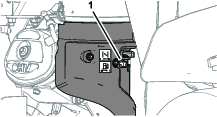
Engine On/Off Switch
Located on the right side of the engine (Figure 9).
Rotate the switch clockwise to the ON position before starting the engine. Rotate the switch counterclockwise to the OFF position to shut off the engine.

Parking-Brake Lever
The parking-brake lever is located above the platform on the right side (Figure 10).
-
To engage the parking brake, push the parking-brake lever down.
Note: The brake lever engages a parking brake in the transaxle.
-
To release the parking brake, pull the lever up.

Note: When parking on a steep slope, chock or block the wheels in addition to engaging the parking brake. When transporting the machine, engage the parking brake and bind the machine to the transport vehicle.
Drive-Wheel-Release Lever
The drive-wheel-release lever is located above the platform on the left side (Figure 10).
Use the drive-wheel-release lever to disengage the hydrostatic-drive system to move the machine by hand.
-
To push or pull the machine, move the drive-wheel-release lever up.
-
To operate the machine, move the drive-wheel-release lever down.
Spreader Controls
Deflector Gate Control
The deflector-gate control is located to the right of the hour meter on the control console (Figure 11).

Use the deflector-gate control to temporarily stop the discharge of granular materials from the left side of the spreader. Close the deflector gate with the control when it is not desirable to broadcast granular materials onto sidewalks, parking lots, or patios.
-
Push the knob for the deflector-gate control down to close the gate and temporarily deflect the granular materials.
-
Pull the knob up to open the deflector gate for full granular broadcasting.
Spreader-Pattern Control
The spreader-pattern control is located to the right of the deflector-gate control at the control console (Figure 11).
Use the spreader-pattern control to broadcast a heavier pattern of granular material to the left or right side of the machine.
-
To broadcast a heavier pattern to the left, unlock the spreader-pattern control, pull the control up slightly, and lock the control.
-
To broadcast a heavier pattern to the right, unlock the spreader-pattern control, push the control down slightly, and lock the control.
Wide-distribution Impeller-Gate Lever
The wide-distribution impeller-gate lever is the fourth lever located at the top center of the control console (Figure 11).
-
To broadcast a wide pattern of granular material, pull the wide-distribution impeller-gate lever rearward fully to the full open position.
-
To close the impeller gate, push the wide-distribution impeller-gate lever forward full closed position.
Narrow-distribution Impeller-Gate Lever
The narrow-distribution impeller-gate lever is the fifth lever located at the top center of the control console (Figure 11).
-
To broadcast a narrow pattern of granular material, pull the narrow-distribution impeller-gate lever rearward fully to the limited OPEN position.
-
To close the impeller gate, push the wide-distribution impeller-gate lever forward fully.
Note: Only the wide-distribution impeller-gate lever closes the impeller gate. Pushing the wide-distribution impeller-gate lever forward also resets the narrow-distribution impeller-gate lever to the forward position.
Narrow-Spreader Distribution Flow-Rate Knob
The narrow-spreader distribution flow-rate knob is located below the wide- and narrow-impeller-gate levers (Figure 11).
Use the narrow-spreader distribution-flow-rate knob to control the discharge rate of granular material from the hopper onto the impeller when the narrow-distribution impeller-gate lever is in the OPEN position (limited).
-
Rotate the narrow-spreader distribution-flow-rate knob clockwise to decrease the discharge rate of granular material from the hopper.
-
Rotate the distribution flow-rate-knob counterclockwise to increase the discharge rate of granular material from the hopper.
Impeller On/Off Switch
The impeller On/Off switch is located below the impeller-distribution flow-rate knob at the bottom of the control console (Figure 11).
Use the impeller On/Off switch to run the electric motor that drives the impeller.
-
Press the impeller On/Off switch up to run the impeller.
-
Press the impeller On/Off switch down to stop the impeller.
Impeller-speed Control
The impeller-speed control is located to the right of the impeller On/Off switch at the bottom of the control console (Figure 11).
Use the impeller-speed control to adjust the rotational speed of the impeller.
-
Rotate the impeller-speed control counterclockwise to decrease the rotational speed of the impeller.
-
Rotate the impeller-speed control clockwise to increase the impeller speed.
Drop-rate Cam and Linkage
The drop-rate cam and linkage are located at the front of the machine and below the hopper on the spreader (Figure 12).
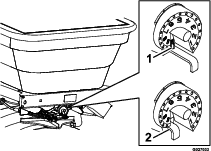
Use the drop-rate cam to set the maximum amount of material to be dispensed through the impeller gate and onto the impeller.
The slot in the cam, after setting 9 on the cam, allows the impeller gate to be opened to the maximum position. This setting can be used for dry sand, ice melt, or other materials that are difficult to spread.
Note: Use cam setting 9 may when you are cleaning out the hopper.
Sprayer Controls
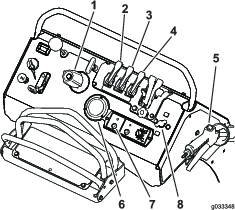
Sprayer Pressure Control
The sprayer-pressure control is located on the control console (Figure 13).
-
Rotate the sprayer-pressure control clockwise to increase the pressure to the sprayer nozzles
-
Rotate the pressure-control counterclockwise to the decrease nozzle pressure.
Tank Agitation Lever
The tank-agitation lever is located on the control console (Figure 13).
Setting the tank-agitation lever to the ON position allows the sprayer pump to circulate the content in the spray tank to keep the chemical solution mixed.
-
Pull the tank-agitation lever rearward to circulate the content in the spray tank.
-
Push the lever forward to stop circulating the content in the spray tank.
Note: Do not use agitation while spraying. Shut off the tank agitation to ensure proper spray distribution.
Note: Run the engine speed above idle and run the sprayer pump for the tank agitation to work effectively.
Narrow-Spray Pattern Lever
The narrow-spray pattern lever is located on the control console (Figure 13).
-
To turn ON the sprayer in a narrow-spray pattern (the center nozzle only), pull the narrow-spray pattern lever toward you.
-
To turn OFF the sprayer, push the narrow-spray pattern lever away from you.
Wide-Spray Pattern Lever
The wide-spray pattern lever is located on the control console (Figure 13).
-
To turn ON the sprayer in a wide-spray pattern (the right and left nozzles), pull the wide-spray pattern lever toward you.
-
To turn OFF the sprayer, push the wide-spray pattern lever away from you.
Sprayer-Pressure Gauge
The sprayer-pressure gauge is located on the control console (Figure 13).
Use the pressure gauge to see the fluid pressure in the sprayer system.
Sprayer-Pump Switch
The sprayer-pump switch is located on the control console (Figure 13).
Use the sprayer-pump switch to start and stop the pump when spraying or circulating the fluid in the sprayer tank (tank-agitation).
-
To start the pump, push down on the top of the sprayer-pump switch.
-
To stop the pump, push down on the bottom of the switch.
Spray-Wand Trigger and Trigger Lock
The spray-wand trigger and trigger lock are located on the bottom of the spray-wand handle (Figure 13 and Figure 14).
-
To use the spray wand, hold the handle of the wand squeeze the trigger.
-
To lock the trigger to the ON position, fully squeeze the trigger against the handle and then latch the trigger lock over the trigger; to unlock the trigger, unlatch the trigger lock from the trigger.
-
Release the trigger to stop the spray.
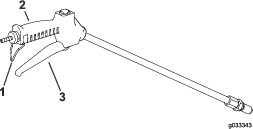
Tank Drain Valve
The tank drain valve is located at the left side and under the sprayer tank (Figure 16).
Use the tank drain valve to empty the sprayer tank of liquid chemicals.

-
To open the valve, rotate the handle of the tank drain valve 90° clockwise (lever in-line with valve).
-
To close the valve, rotate the handle 90° counterclockwise.
Sprayer-Pump-Supply Valve
The sprayer-pump-supply valve is located at the right side of the machine and under the sprayer tank (Figure 16).
Use the sprayer-pump-supply valve to shut off the flow of liquid chemicals to the pump.
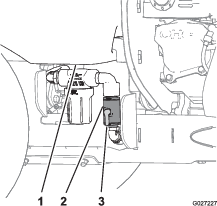
-
To open the valve, rotate the handle valve 90° clockwise (lever in-line with valve).
-
To close the valve, rotate the handle 90° counterclockwise.
| Overall width | 90 cm (35.5 inches) | |
| Overall length | 171 cm (67.5 inches) | |
| Overall height | 131 cm (51.5 inches) | |
| Weight | sprayer tank and hopper empty | 227 kg (500 lb) |
| only hopper full | 307 kg (676 lb) | |
| only sprayer tank full | 309 kg (682 lb) | |
| sprayer tank and hopper empty and 1 extra bag of granular material in the tank | 412 kg (909 lb) | |
| Maximum machine weight | loaded machine + operator | ≤ 513 kg (1130 lb) |
| Hopper capacity | 79 kg (175 lb) | |
| Sprayer tank capacity | 76 L (20 US gallon) | |
| Maximum ground speed | forward | 9 kph (5.5 mph) |
Operation
Note: Determine the left and right sides of the machine from the normal operating position.
Before Operation
Before Operation Safety
General Safety
-
Park the machine on a level surface; shut off the engine; engage the parking brake; remove the key; wait for all movement to stop; and allow the machine to cool before adjusting, cleaning, storing, or servicing it.
-
Never allow children or untrained people to operate the machine. Local regulations may restrict the age of the operator. The owner is responsible for training all operators and mechanics.
-
Become familiar with the safe operation of the equipment, operator controls, and safety signs.
-
Know how to stop the machine and shut off the engine quickly.
-
Check that operator-presence controls, safety switches, and shields are attached and functioning properly. Do not operate the machine unless they are functioning properly.
-
If the machine does not function correctly or is damaged in any way, do not use the machine. Correct the problem before you operate the machine or attachment.
-
Ensure that the operator area is clean and free from chemical residue and debris buildup.
-
Ensure that all fluid line connectors are tight and that all hoses are in good condition before applying pressure to the system.
Chemical Safety
Chemical substances used in the sprayer system may be hazardous and toxic to you, bystanders, and animals, and they may damage plants, soil, and other property.
If you will use more than 1 chemical, read the information on each chemical. Refuse to operate or work on the sprayer if this information is not available.
Before working on a sprayer system, ensure that it has been neutralized and triple rinsed according to the recommendations of the chemical manufacturer(s) and that all the valves have been cycled 3 times.
Verify that there is an adequate supply of clean water and soap nearby, and immediately wash off any chemicals that contact you.
-
Carefully read and follow the chemical warning labels and material safety data sheets (MSDS) for all chemicals used, and protect yourself according to the chemical manufacturer's recommendations.
-
Always protect your body while using chemicals. Use the appropriate personal protective equipment (PPE) to guard against contact with chemicals, such as the following:
-
safety glasses, goggles, and/or face shield
-
a chemical suit
-
a respirator or filter mask
-
chemical-resistant gloves
-
rubber boots or other substantial footwear
-
a clean change of clothes, soap, and disposable towels for cleanup
-
-
Obtain proper training before using or handling chemicals.
-
Use the correct chemical for the job.
-
Follow the chemical manufacturer's instructions for the safely applying the chemical. Do not exceed the recommended system application pressure.
-
Do not fill, calibrate, or clean the machine while people, especially children, or pets are in the area.
-
Handle chemicals in a well-ventilated area.
-
Have clean water available, especially when filling the spray tank.
-
Do not eat, drink, or smoke while working near chemicals.
-
Do not clean spray nozzles by blowing through them or placing them in your mouth.
-
Always wash your hands and other exposed areas as soon as possible after working with chemicals.
-
Keep chemicals in their original packages and stored in a safe location.
-
Properly dispose of unused chemicals and chemical containers as instructed by the chemical manufacturer and your local codes.
-
Chemicals and fumes are dangerous; never enter the tank or place your head over or in the opening of a tank.
-
Follow all local, state, and federal regulations for spreading or spraying chemicals.
Fuel Safety
-
Use extreme care in handling fuel. It is flammable and its vapors are explosive.
-
Extinguish all cigarettes, cigars, pipes, and other sources of ignition.
-
Use only an approved fuel container.
-
Do not remove the fuel cap or fill the fuel tank while the engine is running or hot.
-
Do not add or drain the fuel in an enclosed space.
-
Do not store the machine or fuel container where there is an open flame, spark, or pilot light, such as on a water heater or other appliance.
-
If you spill fuel, do not attempt to start the engine; avoid creating any source of ignition until the fuel vapors have dissipated.
Performing Daily Maintenance
Before starting the machine each day, perform the following daily-check procedures:
Checking the Safety Interlock System
Caution
If interlock switch is disconnected or damaged the machine could operate unexpectedly causing personal injury.
-
Do not tamper with the interlock switch.
-
Check the operation of the interlock switch daily and replace damaged switch before operating the machine.
Important: Ensure that the safety mechanisms on your machine are connected and in proper operating condition prior to operating your machine.
The safety interlock system is designed to prevent the engine from starting unless you engage the parking brake.
Testing the Starter Interlock
| Maintenance Service Interval | Maintenance Procedure |
|---|---|
| Before each use or daily |
|
-
Move the machine to a level surface.
-
Chock the wheels of the machine.
-
Disconnect the spark-plug wires.
-
Release the parking brake.
-
With the motion-control lever in the NEUTRAL position turn the key to the START position.
Note: The starter must not rotate the engine.
-
If the starter rotates the engine of your machine—the machine does not pass this test, do not operate it. Contact your authorized Toro distributor.
-
If the starter does not rotate the engine—the machine does pass the test: engage the parking brake, connect the spark-plug wire to the spark plug, and remove the chock(s) from the wheels.
-
Fuel Specification
| Petroleum fuel | Use unleaded gasoline with an octane rating of 87 or higher ((R+M)/2 rating method). |
| Ethanol blended fuel | Use an unleaded-gasoline blend with up to 10% ethanol (gasohol) or 15% MTBE (methyl tertiary butyl ether) by volume is acceptable. Ethanol and MTBE are not the same. |
| Gasoline with 15% ethanol (E15) by volume is not approved for use. Never use gasoline that contains more than 10% ethanol by volume, such as E15 (contains 15% ethanol), E20 (contains 20% ethanol), or E85 (contains up to 85% ethanol). Using unapproved gasoline may cause performance problems and/or engine damage which may not be covered under warranty. |
Important: For best results, use only clean, fresh fuel (less than 30 days old).
-
Do not use gasoline containing methanol.
-
Do not store fuel either in the fuel tank or fuel containers over the winter unless you use a fuel stabilizer.
-
Do not add oil to gasoline.
Using Stabilizer/Conditioner
Use a fuel stabilizer/conditioner in the machine to provide the following benefits:
Important: Do not use fuel additives containing methanol or ethanol.
Add the correct amount of fuel stabilizer/conditioner to the gasoline.
Note: A fuel stabilizer/conditioner is most effective when mixed with fresh gasoline. To minimize the chance of varnish deposits in the fuel system, use fuel stabilizer at all times.
Filling the Fuel Tank
Fuel tank capacity: 6.8 L (1.8 US gallons)
Note: Refueling the engine is difficult when using a larger refueling container such as a container with a 19 L (5 US gal) capacity.To make fueling the machine easier, use a 4 to 8 L (1 to 2 US gal) fuel container and a funnel.
-
Park the machine on a level surface and shut off the engine.
-
Allow the engine to cool.
-
Clean around the fuel-tank cap and remove it (Figure 17).
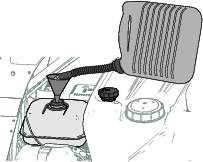
-
Fill the tank with fuel (Figure 17) to within 6 to 13 mm (1/4 to 1/2 inch) from the top of the tank. Do not fill into the filler neck of the tank.
Important: Do not fill the tank more than 6 mm (1/4 inch) from the top of the tank because the fuel needs room to expand.
-
Install the fuel-tank cap securely.
-
Wipe up any spilled fuel.
During Operation
During Operation Safety
General Safety
-
The owner/operator can prevent and is responsible for accidents that may cause personal injury or property damage.
-
Wear appropriate clothing, including eye protection; long pants; substantial, slip-resistant footwear; and hearing protection. Tie back long hair, secure loose clothing, and do not wear loose jewelry.
-
Wear appropriate personal protective equipment as directed in Chemical Safety.
-
Use your full attention while operating the machine. Do not engage in any activity that causes distractions; otherwise, injury or property damage may occur.
-
Do not operate the machine while ill, tired, or under the influence of alcohol or drugs.
-
Never carry passengers on the machine and keep bystanders and pets away from the machine during operation.
-
Do not try to stabilize the machine by putting your foot on the ground. If you lose control of the machine, step off the platform and away from the machine.
-
Do not place your feet under the platform.
-
Do not move the machine unless you are standing with both feet on the platform and your hands are holding onto the reference bars.
-
Operate the machine only in good visibility to avoid holes or hidden hazards.
-
Before you start the engine, ensure that you are in the operating position, the transmission is in neutral, and the parking brake is engaged.
-
Before you start the engine, ensure that you are in the operating position, the transmission is in neutral, and the parking brake is engaged.
-
Use care when approaching blind corners, shrubs, trees, or other objects that may obscure your vision.
-
Ensure that you have good footing while using this machine, especially when backing up.
-
Keep clear of any discharge area of the sprayer nozzles and spray drift. Keep bystanders and pets a safe distance away from the machine.
-
Never spray or spread chemicals while people, especially children, or pets are nearby.
-
Look behind and down before backing up to be sure of a clear path.
-
Use care when approaching blind corners, shrubs, trees, or other objects that may obscure your vision.
-
Do not operate the machine near drop-offs, ditches, or embankments. The machine could suddenly roll over if a wheel goes over the edge or if the edge gives way.
-
Reduce the speed and load when operating on rough terrain, uneven ground, and near curbs, holes, and other sudden changes in terrain. Loads may shift, causing the machine to become unstable.
-
Stop the machine, shut off the engine, remove the key, engage the parking brake, and inspect for damage after striking an object or if there is an abnormal vibration in the machine. Make all necessary repairs before resuming operation.
-
Slow down and use caution when making turns and crossing roads and sidewalks with the machine. Always yield the right-of-way.
-
Use extra caution when operating the machine on wet surfaces, in adverse weather conditions, at higher speeds, or with a full load. Stopping time and distance increase in these conditions.
-
Never run an engine in an enclosed area where exhaust gasses can collect.
-
Never leave a running machine unattended.
-
Do not touch the engine or muffler while the engine is running or soon after it has shut off. These areas may be hot enough to cause burns.
-
Before leaving the operating position, do the following:
-
Stop the machine on level ground.
-
Shut the wide-distribution impeller-gate for the spreader and shut off the sprayer-pump switch.
-
Shut off the engine and remove the key.
-
Engage the parking brake.
-
Wait for all moving parts to stop.
-
-
Do not operate the machine when there is the risk of lightning.
-
Do not use the machine as a towing vehicle.
-
Do not change the governor speed or overspeed the engine.
-
Use accessories and attachments approved by Toro only.
Sprayer and Spreader Operation Safety
-
The spray wand traps liquids under high pressure, even when engine is off. High-pressure spray could cause serious injury or death.
-
Keep clear of nozzle and do not direct spray or stream at people, pets, or non-work area property.
-
Do not direct spray on or near electrical-power components or source.
-
Do not attach hoses or other components to the end of the spray-wand nozzle.
-
Do not attempt to disconnect the spray wand from the machine while the system is pressurized.
-
Do not use spray wand if trigger lock is damaged or missing.
-
Rotate the spray-wand lock to the OFF position when job is complete.
-
-
Do not touch the impeller for the spreader while the impeller is rotating.
-
Stop spreading/spraying when making tight turns to minimize chemical drift.
-
Chemicals may drift and cause injury to people and animals; it may also damage plants, soil, or other property.
-
Liquid loads and granular materials can shift. This shifting happens most often while turning, going up or down hills, suddenly changing speeds, or while driving over rough surfaces. Shifting loads can cause the machine to tip over.
-
Safely relieve pressure from spray wand every time the engine is shut off.
-
When draining or relieving system, do not let anyone stand in front of nozzles and do not drain on a person’s feet.
Slope Safety
Slopes are a major factor related to loss of control and rollover accidents, which can result in severe injury or death. You are responsible for safe slope operation. Operating the machine on any slope requires extra caution.
-
Review the slope instructions listed below for operating the machine on slopes and to determine whether you can operate the machine in the conditions on that day and at that job site. Changes in the terrain can result in a change in slope operation for the machine.
-
Determine if the slope is safe for machine operation, including surveying the site. Always use common sense and good judgment when performing this survey.
-
Avoid starting, stopping, or turning the machine on slopes. Travel up and down on slopes. Avoid making sudden changes in speed or direction. If you must turn the machine, turn it slowly and gradually downhill, if possible. Use care when reversing the machine.
-
Do not operate a machine when you are uncertain about the traction, steering, or stability.
-
Remove or mark obstructions such as ditches, holes, ruts, bumps, rocks, or other hidden hazards. Tall grass can hide obstructions. Uneven terrain could overturn the machine.
-
Be aware that operating the machine on wet surfaces, across slopes, or downhill may cause the machine to lose traction. Loss of traction to the wheels may result in sliding and a loss of braking and steering.
-
Use extreme caution when operating the machine near drop-offs, ditches, embankments, water hazards, or other hazards. The machine could suddenly roll over if a wheel goes over the edge or the edge caves in. Establish a safety area between the machine and any hazard.
-
Use extra care while operating the machine with attachments; they can affect the stability of the machine.
-
If the engine stalls or you begin to lose momentum while climbing a hill, gradually apply the brakes and slowly back straight down the hill.
-
Always keep the transmission in gear (if applicable) when you drive the machine down a slope.
-
Do not park the machine on an incline.
-
The weight of the material in the tank can change the handling of the machine. To avoid loss of control and personal injury, follow these guidelines:
-
When operating with a heavy load, reduce your speed and allow for sufficient braking distance. Do not suddenly apply the brakes. Use extra caution on slopes.
-
Liquid loads shift, especially while turning, going up or down slopes, suddenly changing speeds, or while driving over rough surfaces. Shifting loads can cause the machine to tip over.
-
Operating the Machine
Extending and Retracting the Operator’s Platform
Extending the Operator’s Platform
-
Pull the platform-lock knob inward until the pin of clears the upper hole in the chassis (Figure 18).
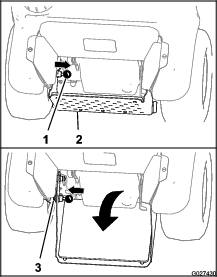
-
Rotate the operator’s platform down until the pin of the platform lock aligns with the lower hole in the chassis (Figure 18).
-
Move the platform-lock knob outward until the pin protrudes through the lower hole (Figure 18).
Retracting the Operator’s Platform
-
Pull the platform-lock knob inward until the pin clears the upper hole in the chassis (Figure 18).
-
Rotate the operator’s platform up until the pin of the platform lock aligns with the upper hole in the chassis (Figure 18).
-
Move the platform-lock knob outward until the pin protrudes through the upper hole (Figure 18).
Opening and Closing the Fuel Shutoff Valve
Control fuel flow to the engine with the fuel shutoff valve as follows:
-
To open the fuel-shutoff valve, fully rotate the handle for the valve left.
-
To close the fuel-shutoff valve, fully rotate the handle of the valve right.
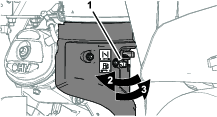
Starting the Engine
-
Ensure that the fuel-shutoff valve is open; refer to Opening and Closing the Fuel Shutoff Valve.
-
Move the steering-control/motion-control lever in NEUTRAL position and engage the parking brake; refer to Steering Control, Motion-Control Lever, and Parking-Brake Lever.
Note: To start the engine, you must engage the parking brake. (You can start the engine while you are off the platform.)
-
Move the throttle lever midway between the SLOW and FAST positions; refer to Throttle Control.
-
If the engine is cold, pull up the choke control to the ON position; refer to Choke Control.
Note: If the engine is warm , push down the choke lever to the OFF position.
-
Rotate the ignition switch to the START position; refer to Ignition Switch.
Note: When the engine starts, release the switch.
Important: Do not crank the engine continuously for more than 10 seconds at a time. If the engine does not start, allow a 60 second cool-down period between starting attempts. Failure to follow these guidelines can overheat the starter motor
-
If the choke control is in the ON position, gradually move the lever down, toward the OFF position as the engine warms up.
Shutting Off the Engine
-
Move the steering-control/motion-control lever to the NEUTRAL position and bring the machine to a full stop; refer to Steering Control and Motion-Control Lever.
-
Place the throttle in the midway between the SLOW and FAST positions; refer to Throttle Control.
-
Run the engine for a minimum of 15 seconds, then turn the ignition switch to the OFF position; refer to Ignition Switch.
-
Engage the parking brake; refer to Parking-Brake Lever.
-
Remove the key; refer to Ignition Switch.
-
Close the fuel-shutoff valve when you are not using the machine for a few days, when transporting it, or when it is parked inside a building; refer to Opening and Closing the Fuel Shutoff Valve.
Positioning the Air-Cleaner Cover for Cold or Warm Air Temperature
Important: Running the engine with the air-cleaner cover positioned for cold-weather operation in normal conditions can damage the engine.
The air-cleaner cover has 2 positions: the cold or normal, ambient air positions:
Adjust the air-cleaner cover as follows:
-
When operating in a cold ambient air condition (cold air temperature and humidity), position the air-cleaner cover with snowflake decal facing out (Figure 20).
Note: Use this position if your machine exhibits carburetor icing. Symptoms include the engine runs rough at idle or low speed, and it discharges black or white smoke in the exhaust.
-
When operating in a normal ambient air condition, position the air-cleaner cover with sun decal facing out (Figure 20).
Note: Use this position if your machine is not exhibiting carburetor icing.
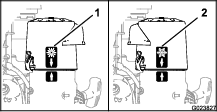
Driving the Machine
Caution
Machine can turn rapidly by moving the steering control to the far right or left. Operator may lose control of the machine, which may cause damage to the machine or injury.
-
Use caution when making turns.
-
Slow down the machine before making sharp turns.
Important: If the motion-control lever does not return to the NEUTRAL position when you release it, contact an Authorized Service Dealer.
Important: To begin moving the machine (forward or backward), the parking-brake lever must be released (pulled up) before you move the motion-control lever.
Driving the Machine Forward
-
Move the motion-control lever to the NEUTRAL position.
-
Release the parking brake.
-
To drive the machine, perform the following:
-
To move the machine forward in a straight line, center the steering control and move the motion-control lever forward.
Note: The machine moves faster the farther you move the motion-control lever away from the NEUTRAL position.
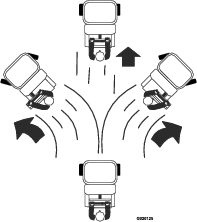
-
To turn left or right, move the steering control toward the desired turn direction.
-
To stop the machine, move the motion-control lever in the NEUTRAL position.
Note: Stopping distance may vary depending on the spreader-sprayer load.
Note: When you release the motion-control lever, it automatically returns to the NEUTRAL position.
-
Driving the Machine in Reverse
-
Move the motion-control lever to the NEUTRAL position.
-
To move the machine rearward in a straight line, slowly move the motion-control lever rearward.

To turn left or right, move the steering control toward the desired turn direction.
-
To stop the machine, move the motion-control lever to the NEUTRAL position.
Note: Stopping distance may vary depending on the spreader-sprayer load.
Operating the Spreader
Caution
Chemicals are hazardous and can cause personal injury.
-
Read the chemical manufacture’s directions on the label before handling the chemicals; follow all manufacturer recommendations and precautions.
-
Keep chemicals away from your skin. Should contact occur, wash the affected area thoroughly with soap and clean water.
-
Wear eye protection, gloves, and any other protective equipment recommended by the chemical manufacturer.
Use the spreader to disperses free-flowing granular substances such as grass seed, fertilizer, ice melt, etc. When you use the spreader, first fill the granular hopper, then apply the granular materials to the work site, and finally clean the hopper.
Important: When you use your spreader, thoroughly clean it at the end of the day.
Before Operating the Spreader
Before you start using the spreader, calibrate the spreader for the material that you will disperse; refer to Calibrating the Spreader.
Important: Prior to filling the hopper, verify that you have set the proper spreader-application rate.
Calibrating the Spreader
Calibrate the spreader each time you use a new material. The spreader broadcasts material in a pattern 1.5 to 6.7 m (5 to 22 ft) wide depending on the material particle size, volume/density, rate of travel, and wind conditions.
Use the Spreading Charts along with information from Determining the Distribution Pattern, Determining the Effective Spreading Width, and Calculating the Application Rate when calibrating the spreader.
Preparing the Test Site and Machine
Operator supplied equipment: 15 shallow collection pans and 15 graduated measuring cylinders
Note: The most accurate method to measure the distribution uses shallow collection pans and graduated measuring cylinders. In the example below, the 15 shallow collection pans approximately 30 cm (12 inches) wide, 91 cm (36 inches) long, and 5 cm (2 inches) tall.
-
Place one pan in the center of the drive path. Arrange the next two pans, one on each side, far enough apart to allow adequate room for the drive tires of the machine to pass around the center pan.
-
Place the remaining pans in a straight line as shown in Figure 23 or Figure 24.
-
Move the machine far enough away from the test area (where the collection pans are located) to ensure that the machine travels at the desired spreading speed before reaching the site.
-
Determine the application rate and the related drop-rate cam setting; refer to Spreading Charts.
-
Rotate the drop rate cam (Figure 25) to the cam setting you determined in step 4.
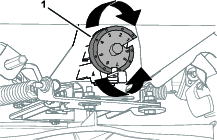
-
Fill the hopper approximately half-full with the desired material; refer to Filling the Spreader Hopper.
Determining the Distribution Pattern
-
Set the spreader pattern control to the middle of its travel; refer to .
-
Set the impeller speed to the appropriate broadcasting rate.
-
Drive the machine toward the test site at the appropriate speed.
-
As you approach the center pan, pull the wide distribution granular gate control to the open position, and drive over the center pan.
-
Close the gate control, move motion-control lever to the NEUTRAL position, shut off the engine, wait for all moving parts to stop, remove key, and engage parking brake.
-
Label each graduated measuring cylinder to correspond with the distribution pans (such as L2, L1, Center, R1, R2); refer to Figure 23 and Figure 24.
-
One at a time, take a collection pan and dump the contents into the corresponding graduated cylinder. Record the amount of material collected and return the pan to its location. Repeat this until all pan contents have been emptied.
Note: Repeat broadcasting over the test site several times, moving in the same direction each time, until enough material is dispensed to the collection pan to half fill a graduated cylinder.
-
With the graduated measuring cylinder in the same straight line as the pans, evaluate the volume of material in each cylinder to determine the quality of the distribution from the spreader.
-
To adjust the spreader pattern, refer to the Adjusting the Spreader Pattern.
-
Fill the hopper half-full of the desired material and repeat steps 1 through 9 until you achieve a uniform pattern.
Determining the Effective Spreading Width
Use the effective width to determine the uniform distribution of the material.
Note: The spreading width range is 6 to 8 m (20 to 25 ft).
-
After the spreader pattern is correctly adjusted, evaluate the amount of material in the center graduated measuring cylinder.
-
Locate the 2 graduated cylinder, one each side of center, that contain 1/2 the measured amount of the material that you observed in the center graduated cylinder.
-
Go to the two corresponding pans. Starting from the outer edge, measure the distance between left pan, across the center pan, to the outer edge of the right pan, and record the measurement.
Record the effective spreading width here:.
Preparing the Calibration Course for Calculating the Application Rate
-
Determine a course length by dividing 93 m2 (1,000 ft2) by the effective spread width that you determined in Determining the Effective Spreading Width; use the course length formula. Record the course length here:.
Calibration Course Length Formula
Formula 93 m2(1,000 ft2) / Effective width measurement = Calibration course length Example 93 m2(1,000 ft2) / 1.8 m (6 ft) = 51 m (167 ft) Note: In this example the effective width measures 1.8 m (6 ft).
-
Measure and visibly mark the course length. Ensure that you allow enough distance before the starting marker so that the spreader moving forward at full speed when crossing the first mark of the course.
Calculating the Application Rate
-
Determine the area and amount of material that you are applying to the job site and record those amounts in the area and materials worksheet.
Record the job site area here:.
Record the amount of job site material here:.
-
Initially, use the recommended application rate indicated in theSpreading Charts section or use the rate recommended listed on the product manufacturer’s label as a guide to help determine the amount of material that you would spread over a 93 m2 (1,000 ft2) area.
Note: In this example the calibration course is 1.8 m (6 ft) by 51m (167 ft).
-
Set the appropriate drop-rate cam setting; refer to the Spreading Charts as a starting point.
-
Add material to the hopper.
Note: In this example we added 11.3 kg (25 lb) of material.
-
Drive the spreader over the calibration course while applying the material.
-
Empty the remaining material of the hopper into a clean bucket; refer to Emptying the Spreader.
-
Weigh the bucket containing the material and record the weight. Pour the contents back into the hopper and then weigh the empty bucket. Calculate the remaining material weight using the remaining material weight formula. Record the remaining material weight here:.
Remaining Material Weight Formula
Formula (Remaining material and bucket weight) - (Bucket weight) = Remaining material weight Example 10 kg (22 lb) — 1 kg (2 lb) = 9 kg (20 lb) Note: In this example, 9 kg (20 lb) of material remain in the hopper after applying the material to the test course.
-
Calculate applies material weigh using the applied material formula that follows. Record the applied material weight here:.
Applied Material Weight Formula
Formula (Original material weight) - (Remaining material weight) = Applied material weight Example 11.3 kg (25 lb) — 9 kg (20 lb) = 2.3 kg (5 lb) 3 Note: This calculation means that 2.3 kg (5 lb) of material was applied to the 93 m2 (1,000 ft2) test course.
-
If necessary, adjust the drop-rate cam to achieve the recommended application rate. Once you achieve the correct application rate, repeat this procedure an additional time to verify your results.
Important: Designate a new calibration course each time, so that the turf is not damaged by excessive application of material.
Filling the Spreader Hopper
Maximum hopper weight capacity: 79 kg (175 lb)
-
Drive the machine to the work site.
-
Move the machine to a level surface, move motion-control lever to the NEUTRAL position, shut off the engine, wait for all moving parts to stop, remove key, and engage parking brake.
-
Ensure that the wide-distribution impeller-gate lever is in the fully forward (closed) position; refer to Wide-distribution Impeller-Gate Lever.
-
Use the Spreading Charts to determine the setting for the drop-rate cam (Figure 26).
Note: If the setting is not listed for the type of material that you are using, set the cam to the setting with a lower value then adjust as needed.
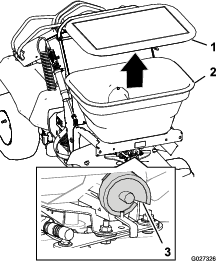
-
Remove the cover from the hopper, add the material that you are spreading, and install the cover onto the hopper (Figure 26).
Note: Do not overload the hopper; the maximum weight capacity of the hopper is 79 kg (175 lb).
Note: You may place 1 extra bag of granular product on top of the sprayer tank if necessary.
Emptying the Spreader
Removing the Impeller
-
Move the machine to a level surface, move motion-control lever to the NEUTRAL position, shut off the engine, wait for all moving parts to stop, remove key, and engage parking brake.
-
Empty the hopper by scooping out as much of the material as possible.
-
Remove the 4 thumbscrews that secure the front cover ( below the impeller) to the chassis, and remove the cover (Figure 27).
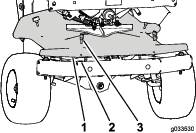
-
Remove the drive pin that secure the impeller to the shaft of the impeller motor, and remove the impeller from the shaft (Figure 28 and Figure 29).

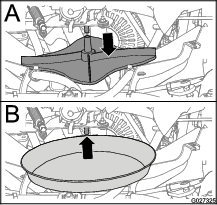
-
Place a shallow pan under the shaft of the impeller motor (Figure 29).
Disconnecting the Rate-Gate Linkage
-
Push the locking sleeve for the gate cable rearward and lift the cable up from the ball stud of the rate-gate linkage (Figure 30).

-
Pull the cable off the ball stud (Figure 30).
-
Rotate the drop-rate cam past position-9 so that the slot in the cam aligns with the linkage (Figure 30).
-
Fully push the rate-gate linkage rearward (Figure 30).
-
If there is material in the hopper allow the material to pour into a shallow pan; when the hopper is empty, remove the pan.
Connecting the Rate-Gate Linkage
Assembling the Impeller
-
Assemble impeller onto the impeller shaft and secure the impeller with the drive pin.
-
Align the holes in the front cover with the clip nuts in the chassis and secure the cover with the 4 thumbscrews that you removed in step 3 of Removing the Impeller.
Using the Spreader
Spreading Charts
Note: The cam setting tables for pellet material and the grass seed are provided with permission from the Brinly-Hardy Company; reference the Brinly-Hardy Company website for more information.
Use these charts as an approximate guideline only. Other factors, such as weather conditions, spreader operation, and the condition of material affects spreader performance.
| Type | kg per 93 m2 (lb per 1,000 ft2) | Cam Setting — One Pass | Cam Setting — Two Passes |
| Fine Pellets | 0.5 (1) | 3.6 | 3.1 |
| 0.9 (2) | 4.0 | 3.5 | |
| 1.4 (3) | 4.2 | 3.7 | |
| Mixed Fine Pellets | 0.9 (2) | 3.7 | 3.2 |
| 1.8 (4) | 4.7 | 4.1 | |
| 2.7 (6) | 5.2 | 4.5 | |
| Small Pellets | 0.9 (2) | 3 | 2.2 |
| 1.8 (4) | 4.2 | 3.7 | |
| 2.7 (6) | 4.5 | 4 | |
| Nitrogen Pellets Medium Size | 0.5 (1) | 3.5 | 3 |
| 0.9 (2) | 4.2 | 3.7 | |
| 1.4 (3) | 4.7 | 4 | |
| Medium Pellets and Granules | 0.9 (2) | 3.5 | 3 |
| 1.8 (4) | 4.2 | 3.8 | |
| 2.7 (6) | 5.2 | 4.5 | |
| Large Heavy Pellets | 0.9 (2) | 3.8 | 3.3 |
| 1.8 (4) | 4.9 | 4.1 | |
| 2.7 (6) | 5.9 | 4.9 |
Use the chart below for reference only. When spraying and spreading at the same time, set the spread pattern to twice the width of the spray; this will help avoid striping and streaking. For example, standard spray width = 2.7 m (9 ft) and spread width = 5.4 m (18 ft).
| Type | Bag Weight | Coverage - m2 (ft2) | Cam Setting – Full Rate | Cam Setting – Half Rate | Spreader Width |
|---|---|---|---|---|---|
| Blue Grass or Red Top | 0.23 kg (0.5 lb) | 93 (1,000) | 1.25 | 4 | |
| 0.45 kg (1 lb) | 93 (1,000) | 2.0 | 4 | ||
| 0.9 kg (2 lb) | 93 (1,000) | 2.5 | 4 | ||
| Park, Merion, Delta, or Kentucky Bluegrass | 2.27 kg (.5 lb) | 93 (1,000) | 2.5 | 4 | |
| 0.45 kg (1 lb) | 93 (1,000) | 3.0 | 4 | ||
| 0.9 kg (2 lb) | 93 (1,000) | 3.5 | 4 | ||
| Hulled Bermuda | 0.9 kg (2 lb) | 93 (1,000) | 2.75 | 2.25 | 6 |
| 1.36 kg (3 lb) | 93 (1,000) | 3.0 | 2.5 | 6 | |
| 1.81 kg (4 lb) | 93 (1,000) | 3.25 | 2.75 | 6 | |
| Mixtures Including Coarse Seeds | 0.9 kg (2 lb) | 93 (1,000) | 6.0 | 6 | |
| 1.81 kg (4 lb) | 93 (1,000) | 7.0 | 6 | ||
| 2.72 kg (6 lb) | 93 (1,000) | 7.0 | 6 | ||
| Rye Grasses or Tall Fescue | 0.9 kg (2 lb) | 93 (1,000) | 6.0 | 6 | |
| 1.81 kg (4 lb) | 93 (1,000) | 7.0 | 6 | ||
| 2.72 kg (6 lb) | 93 (1,000) | 7.75 | 6 | ||
| Dichondra | 113 kg (4 oz) | 93 (1,000) | 1.9 | 8 | |
| 227 g (8 oz) | 93 (1,000) | 2.1 | 8 | ||
| 340 g (12 oz) | 93 (1,000) | 2.5 | 8 | ||
| Pensacola Bahia | 1.81 kg (4 lb) | 93 (1,000) | 4.5 | 3.75 | 7 |
| 2.27 kg (.5 lb) | 93 (1,000) | 4.75 | 4.0 | 7 | |
| 2.72 kg (6 lb) | 93 (1,000) | 5.0 | 4.25 | 7 |
Adjusting the Spreader Pattern
If the spreader casts material unequally side-to side—too light/heavy to one side—(see Figure 31 and Figure 32), adjust the spreader-pattern.
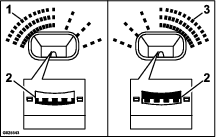
Note: Do not adjust the ramps that split the product flow. Adjust only the front or rear ramp positions.
Using the Deflector Gate
Use the deflector-gate control to temporarily stop or deflect granular material away from sidewalks, parking lots, patios, or anywhere the granular chemicals are not desired.
Note: The deflector gate changes the discharged of materials from the left side of the spreader only.
-
Push the knob for the deflector-gate control down to lower the deflector and temporarily block the granular material.
-
Pull the knob to raise the deflector to cast materials normally at the left side of the machine.
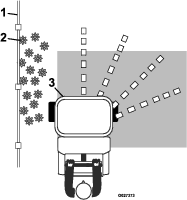
Spreading Material
-
Start the engine and place the throttle midway between the SLOW and the FAST positions.
-
Set the impeller-speed control to appropriate broadcast rate and then press the impeller On/Off switch to the ON position (Figure 34).
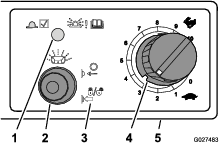
-
To lock the impeller speed control, press and hold the impeller On/Off switch for 5 seconds (Figure 34).
Note: The indicator light above the impeller On/Off switch will flash at a constant rate. If the impeller-speed control is locked (indicated by the flashing indicator light), the impeller motor will start and run at the last locked speed.
-
To unlock the impeller-speed control, start the impeller motor and then press and hold press and hold the On/Off switch for 5 seconds (the indicator light will illuminate steadily).
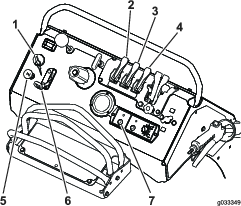
-
-
Move the throttle to the FAST position and drive the machine forward.
-
Open the either the narrow or wide impeller-gate lever to begin spreading (Figure 36).
Note: Use the narrow-spreader distribution flow-rate knob to control the discharge rate of the granular material from the hopper onto the impeller when the narrow-distribution impeller-gate lever is in the OPEN position.
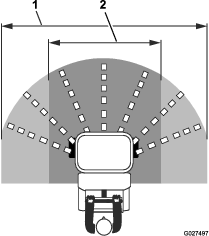
-
Evaluate the spread pattern.
Note: If you need to adjustment the spreading pattern, refer to Adjusting the Spreader Pattern.
-
When you are finished spreading, close the wide-distribution impeller-gate lever.
Note: Only the wide-distribution impeller-gate lever closes the impeller gate. Pushing the wide-distribution impeller-gate lever forward also resets the narrow-distribution impeller-gate lever to the forward position.
-
Clean the hopper after each spreading session; refer to Cleaning and Lubricating the Spreader.
Important: Always empty and clean the spreader immediately after each use. Failure to do so may cause the chemicals to corrode the spreader and other components.
Spreading Tips
Important: Ensure that you calibrate the spreader before you start using it.
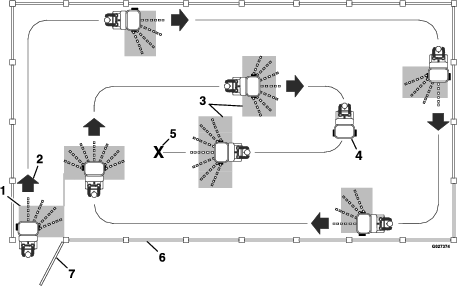
-
To ensure uniform application, broadcast the material in an overlapping pattern as shown in Figure 37.
Note: The highest amount of material will dispense from the front of the hopper and less material from each side. You can adjust the distribution pattern to achieve the desired results.
-
Watch for changes in the distribution pattern; unequal distribution may lead to striping.
Operating the Sprayer
Caution
Chemicals are hazardous and can cause personal injury.
-
Read the chemical manufacture’s directions on the label before handling the chemicals; follow all manufacturer recommendations and precautions.
-
Keep chemicals away from your skin. Should contact occur, wash the affected area thoroughly with soap and clean water.
-
Wear eye protection, gloves, and any other protective equipment recommended by the chemical manufacturer.
Use the sprayer to disperse liquid herbicides, pesticides, fertilizers, and other substances. Before using the sprayer ensure that you have cleaned the tank, plumbing, and nozzles before adding any chemicals. When you use the sprayer, you first fill the spray tank, then apply the chemical solution to the work site, and then when you are finished spraying, clean the tank. It is important to complete all 3 of these steps to avoid damaging the sprayer. For example, Do not mix and add chemicals in the spray tank the night before and then spray in the morning. This could lead to separation of the chemicals and possible cause damage to components of the sprayer.
Important: When you use your sprayer, thoroughly clean it at the end of the day.
Calibrating the Sprayer
Note: Before you use the sprayer for the first time or change the nozzles or when the sprayer is out of adjustment—calibrate the sprayer for ground speed and flow rate.
Note: The left and right sprayer boom nozzles are wide pattern (white) nozzles and the center nozzle is a narrow pattern (red) nozzle.
Note: Refer to the chemical product label for application rate recommendations.
The method to calibrate the sprayer flow involves driving a preset distance, recording the time, and then measuring the amount of liquid applied during that time.
Calculating the Ground Speed
Operator supplied equipment: Stop watch capable of measuring ± 1/10 second.
-
Measure and visibly mark a course length used to calculate the average ground speed. Record the course length here:.
Note: In this example the course length is 45.7 m (150 ft).
-
Add clean water into the spray tank until it is 1/2 full; refer to Filling the Spray Tank.
-
Drive the machine to an area far enough away from the course so that when you are driving it into the course, the machine travels at the desired ground speed before reaching the first marker.
-
Use a stop watch to measure the time (in seconds) that it takes the machine to travel the marked course (45.7 m (150 ft) in this example) while maintaining the desired ground speed. Record your course time in the course time worksheet.
Course Time Worksheet
Time Test 1 seconds Test 2 seconds Test 3 seconds -
Repeat steps 2 through 4 an additional 2 times.
-
Move the sprayer to a level surface, move the motion-control lever in the NEUTRAL position, shut off the engine, wait for all moving parts to stop, remove key, and engage parking brake.
-
Average the 3 test run times (in seconds); use the average course time formula. Record the average course speed here:.
Average Course Time Formula
Formula (time 1) + (time 2) + (time 3) seconds = The average time to drive the course 3 Example 21.6 + 19.1+ 18.4 seconds = 19.7 seconds 3 -
Calculate the average ground speed; use the ground speed formula. Record the average ground speed here:.
Note: 1 kph = 16.6 m/minute (1 mph = 88 ft/minute)
Ground Speed Formula
Formula Course lengthm (ft) x 60 seconds = Ground speed kph (mph) Course time (seconds) x16.7 m/minute (88 ft/minute) Example 45.7 m (150 ft) x 60 seconds = 8.4 kph(5.2 mph) 19.7 seconds x 16.6 m/minute (88 ft/minute)
Understanding the Effective Spray Pattern Width
Testing the Sprayer Nozzle Discharge
Operator supplied equipment: Stop watch capable of measuring ± 1/10 second and a container graduated in 50 ml (1 fl oz) increments.
Note: Ensure that the spray system is clean and there is 1/2 tank of clean water.
-
Engage the parking brake and start the engine.
-
Set the pump/tank agitation switch to the ON position.
-
Pull the agitation lever rearward to start the tank agitation.
-
Place the throttle to the FAST position.
-
Push the agitation control lever down to the OFF position.
Note: Shut off the agitation to ensure proper spray pressure and distribution.
-
Use the spray-pressure control to adjust the sprayer-system pressure to 40 psi (2.8 bar).
Note: The red and white nozzles installed on this sprayer have a normal operating pressure of 40 psi (2.8 bar).
-
Align the graduated container under each nozzle for 19.7 seconds.
Note: Record the amount of water collected from each nozzle in the collection worksheet.
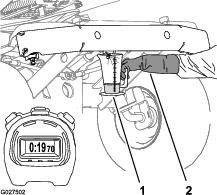
Collection Worksheet
Left sprayer nozzle Center sprayer nozzle Right sprayer nozzle Test 1 ml (fl oz) ml (fl oz) ml (fl oz) Test 2 ml (fl oz) ml (fl oz) ml (fl oz) Test 3 ml (fl oz) ml (fl oz) ml (fl oz) -
Repeat test step 7 for each nozzle an additional 2 times.
-
Turn off the pump/tank agitation switch.
-
Calculate the average quantity of water discharged for each nozzle; use average discharge formula.
Average Discharge Formula
Formula test 1 + test 2 + test 3 = The average spray nozzle discharge in 19.7 seconds 3 Example center nozzle—narrow pattern (red) 475 ml (16.05 fl oz) + 507 ml (17.15 fl oz) + 504 ml (17.05 fl oz) = 0.49 L (16.75 fl oz) 3 -
Right nozzle—record the average discharge quantity here:.
-
Center nozzle—record the average discharge quantity here:.
-
Left nozzle—record the average discharge quantity here:.
-
Converting the Time and Collection Results to Flow Rate
-
Convert the milliliters (fluid ounce) quantities that you calculated in step 10 of Testing the Sprayer Nozzle Discharge to liters (US gallons) using the quantity conversion formula.
Note: 1 L = 1000 ml1 US gallon = 128 fl oz
Quantity Conversion Formula
Formula Result (X) ml (fl oz) = (X) L (US gallon) 0.1 L (128 fl oz) Example center nozzle—narrow pattern (red) 490 ml (16.75 fl oz) = 0.49 L (0.13 US gallon) 0.1 L (128 fl oz) -
Right nozzle—record the converted collected-water quantity here:.
-
Center nozzle—record the converted collected-water quantity here:.
-
Left nozzle—record the converted collected-water quantity here:.
-
-
Calculate the flow rate of each nozzle using the calculated flow-rate formula.
-
Calculated Flow-Rate Formula
Formula Result (X) L (US gallon) x 60 seconds = (X) L (US gallon) 19.7 seconds Example center nozzle—narrow pattern (red) .49 L (0.13 US gallon) x 60 seconds = 3.07 L (0.40 US gallon) per minute 19.7 seconds -
Right nozzle—record the calculated flow rate here:.
-
Center nozzle—record the calculated flow rate here:.
-
Left nozzle—record the calculated flow rate here:.
Note: If the collected nozzle spray does not meet the quantity in the Nozzle Flow Rate Chart, check the nozzles, hoses, and fittings for leaks, damage, or wear; clean or replace the spray nozzles if needed.
-
Nozzle Flow Rate Chart
Use the nozzle flow rate charts determine spray nozzle performance:
-
Nozzle flow rates at different spray-system pressures
-
Worn or damaged spray nozzles
The following chart is based on the nozzle capacity information chart provided with permission from TeeJet® Technologies. Use the chart below or reference the TeeJet® Technologies website to determine if the flow rate of the sprayer nozzle is within the specified flow rate (+/– 10%).
Note: The chart information below is based on the machine spraying water at 70°F (21°C).
| Pressure | Flow Rate—New | Flow Rate—In Service Nozzle | ||
| 0.7 bar(10 psi) | 769 ml (26 fl oz)/min | 0.76 L (0.20 US gallon)/min | 0.68 to 0.75 L (0.18 to 0.22 US gallon)/min | |
| 1.4 bar(20 psi) | 1065 ml (36 fl oz)/min | 1.06 L (0.28 US gallon)/min | 0.95 to 1.17 L (0.25 to 0.31 US gallon)/min | |
| 2.1 bar(30 psi) | 1331 ml (45 fl oz)/min | 1.32 L (0.35 US gallon)/min | 1.19 to 1.45 L (0.32 to 0.39 US gallon)/min | |
| 2.8 bar(40 psi) | 1508 ml (51 fl oz)/min | 1.51 L (0.40 US gallon)/min | 1.36 to 1.66 L (0.36 to 0.44 US gallon)/min | |
| Pressure | Flow Rate—New | Flow Rate—In Service Nozzle | ||
| 0.7 bar(10 psi) | 1508 ml (51 fl oz)/min | 1.51 L (0.40 US gallon)/min | 1.36 to 1.66 L (0.36 to 0.44 US gallon)/min | |
| 1.4 bar(20 psi) | 2159 ml (73 fl oz)/min | 2.16 L (0.57 US gallon)/min | 1.94 to 2.38 L (0.51 to 0.63 US gallon)/min | |
| 2.1 bar(30 psi) | 2602 ml (88 fl oz)/min | 2.61 L (0.69 US gallon)/min | 2.35 to 2.87 L (0.62 to 0.76 US gallon)/min | |
| 2.8 bar(40 psi) | 3017 ml (102 fl oz)/min | 3.03 L (0.80 US gallon)/min | 2.73 to 3.33 L (0.72 to 0.88 US gallon)/min | |
Determining Application Rate
Use the example results of the calculated speed, spray width, and nozzle capacity to determine the application rate.
Note: The application rate may also be determined by using the Nozzle Flow Rate Chart, along with the chemical manufacturer’s label of recommendation.
The examples below are based on the following information:
-
Average ground speed = 8.4 kph (5.2 mph)
-
Spray width = 2.7 m (108 inches)
-
Number of nozzles = 2
-
Nozzle capacity = 3.0 L/min (0.8 gpm)
Note: The numbers 6 and 600 are constants used in the formulas shown below.
| Single nozzle capacity (Lpm) x Number of nozzles x 6 | = | L |
| Speed (kph) x Spray width (m) | 100 m2 |
| 2.99 Lpm x 2 x 6 | = | 1.563 L/100 m2(1.5 qt/1,000 ft2) |
| 8.369 kph x 2.743 m |
| Single nozzle capacity (Lpm) x Number of nozzles x 600 | = | L |
| Speed (kph) x Spray width (m) | hectar |
| 2.99 Lpm x 2 x 600 | = | 156 L/hectar(16.7 gal/acre) |
| 8.369 kph x 2.743 m |
Note: The numbers 544; 136; and 5,940 are constants used in the formulas shown below.
| Single nozzle capacity (gpm) x Number of nozzles x 544 | = | qt |
| Speed (mph) x Spray width (inches) | 1,000 ft2 |
| 0.79 gpm x 2 x 544 | = | 1.5 qt/1,000 ft2(1.5 L/100 macre2) |
| 5.2 mph x 108 inches |
| Single nozzle capacity (gpm) x Number of nozzles x 136 | = | gal |
| Speed (mph) x Spray width (inches) | 1,000 ft2 |
| 0.79 gpm x 2 x 136 | = | 0.38 gal/1,000 ft2(1.5 L/100 m2) |
| 5.2 mph x 108 inches |
| Single nozzle capacity (gpm) x Number of nozzles x 5,940 | = | gal |
| Speed (mph) x Spray width (inches) | acre |
| 0.79 gpm x 2 x 5,940 | = | 16.7 gal/acre(156.1 L/ha) |
| 5.2 mph x 108 inches |
Using the Sprayer
Before Operating the Sprayer
Some chemicals are more aggressive than others and each chemical interacts differently with various materials. Some consistencies of sprayer chemicals (e.g. wettable powders, charcoal) are more abrasive and lead to higher-wear rates. If a chemical is available in a formulation that would provide increased life to the sprayer, use this alternative formulation.
Calibrate the sprayer before you start the spray application; refer to Calibrating the Sprayer.
Filling the Spray Tank
Important: Ensure that the chemicals that you are using in the sprayer are compatible for use with O-rings and seals made from fluoroelastomer material (refer to the chemical manufacturer's label; it should indicate if it is not compatible). If you use a chemical that is not compatible with fluoroelastomer material, the O-rings and seals in the sprayer can degrade and leak.
Important: Before applying chemicals to the job site, verify that you have set the proper application rate prior to filling the tank.
-
Move the machine to a level surface, move motion-control lever to the NEUTRAL position, shut off the engine, wait for all moving parts to stop, remove key, and engage parking brake.
-
Ensure that the narrow-spray pattern and wide-spray pattern levers are in the OFF position and the handle for the drain valve for the tank rotated 90° counterclockwise to the is CLOSED position (Figure 41).
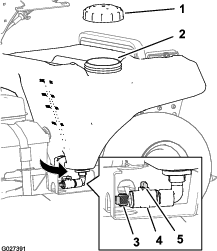
-
Determine the amount of water needed to mix the amount of chemical needed as specified by the chemical manufacturer.
-
Open the tank cap on the spray tank (Figure 41).
-
Add 3/4 of the required water to the sprayer tank through the filler neck.
Important: Always use fresh, clean water in the spray tank. Do not pour chemical concentrate into an empty tank.
-
Rotate the pump-shutoff valve clockwise to the OPEN position (Figure 42).
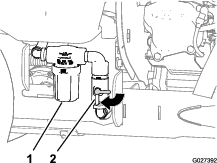
-
Start the engine and set the throttle midway between the SLOW and FAST positions.
-
Set the sprayer-pump switch to the ON position (Figure 43).

-
Move the throttle to the FAST position.
-
Pull rearward on the tank-agitation lever to the ON position.
Note: The water in the tank will circulate.
-
Add the specified amount of chemical concentrate to the tank as directed by the chemical manufacturer.
Important: If you are using a wettable-powder chemical, mix the powder with a small amount of water to form a liquid slurry before adding the chemical mixture to the tank.
-
Add remaining water to the tank and install cap onto the filler neck of the tank.
Note: Allow the content of the sprayer tank to mix thoroughly.
Emptying the Sprayer Tank
Operator supplied equipment:
-
A drain hose with a 1/2–14 inch NPT male coupling
-
A drain container (capacity varies with remaining sprayer tank content)
-
PTFE thread sealant
-
Move the machine to a level surface at the designated area for emptying and cleaning the sprayer tank, move motion-control lever to the NEUTRAL position, shut off the engine, wait for all moving parts to stop, remove key, and engage parking brake.
-
Remove the plug from the drain valve for the sprayer tank (Figure 44).
Note: The drain valve is located at the left side of the machine.
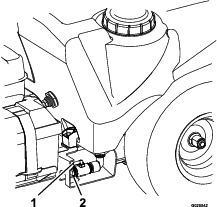
-
Thread a drain hose (operator provided) into the end of the drain valve.
-
Put the free end of the drain hose into a container with enough capacity to hold the remaining content of the sprayer tank.
Note: Use the quantity marks at the front, left side of the sprayer tank for determine the quantity of chemical solution in the tank.
-
Rotate the handle for the drain valve clockwise 90° to drain the tank (Figure 44).
Allow the sprayer tank to drain completely.
-
Apply PTFE thread sealant to the threads of the plug.
-
Close the tank-drain valve, remove the drain hose, and install the drain plug into the valve (Figure 44).
Note: Dispose of the sprayer chemicals according to local codes and the chemical manufacturer's instructions.
Spraying with the Sprayer Boom
Important: To ensure that your chemical solution remains well mixed, use the agitation feature whenever you have solution in the tank. For the agitation feature to work, set the sprayer-pump switch to the ON position, pull back the tank-agitation lever, and run the engine at high idle. If you shut off the machine and agitation is needed, leave the motion-control lever in the NEUTRAL position, engage the parking brake, increase the throttle to the FAST position, switch on the pump and set agitation lever.
Note: Calibrate the sprayer before you start the spray application; refer to Calibrating the Sprayer.
-
Set the sprayer-pump switch to the ON position.
-
Drive the machine to the job site.
-
Push forward the tank-agitation lever to the OFF position.
Note: There is some agitation effect even while the tank-agitation lever is in the OFF position.
-
Adjust the sprayer-pressure control to the setting that you determined in Calibrating the Sprayer.
-
Move the narrow or wide-spray pattern lever to the ON position and begin spraying.
Important: Do not use both the narrow and wide controls at the same time.
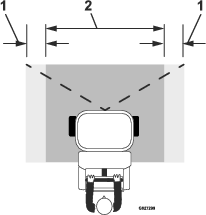

-
When you finish spraying, push forward the spray-pattern levers and set the sprayer-pump switch to the OFF position.
Note: If you need to continue to mix the sprayer tank contents, leave the sprayer-pump switch in the ON position and pull back the tank-agitation lever.
Spraying Tips
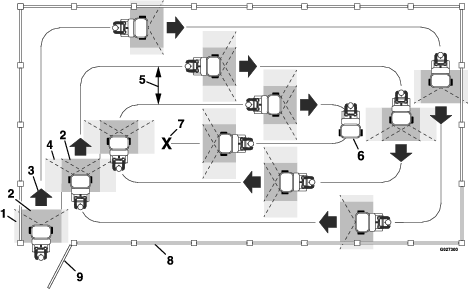
-
Do not overlap the effective spray area that you have previously sprayed (see Figure 47).
-
Watch for plugged sprayer nozzles.
-
Move the narrow-and wide-spray pattern levers to the OFF position to stop the spray flow before stopping the motion of the machine. Once stopped, leave the motion-control lever in NEUTRAL and leave the sprayer-pump switch in the ON position.
-
You obtain better results if the machine is moving when spray controls are turned ON.
-
Ensure adequate pump pressure for proper spray distribution by push forward the tank-agitation lever to the OFF position.
-
Watch for changes in the application rate. Changes in the application rate indicate that your ground speed has changed beyond the operating range of the nozzles or there is a problem with the sprayer system.
Note: When the tank is nearly empty, the tank agitation may cause foaming of the chemical solution in the tank. In this case, push forward the tank agitation lever to the OFF position. Alternatively, if an anti-foaming agent compatible with the existing chemical—add the anti-foaming agent according to the manufacturer’s instructions.
Spraying with the Spray Wand
Warning
The spray wand traps liquids under high pressure, even when engine is off. High-pressure spray discharge could cause serious injury or death.
-
Keep clear of the nozzle and do not direct the spray or stream from the wand at people, pets, or non-work area property.
-
Do not direct the spray at or near electrical-power components or source.
-
Do not repair the spray wand, hoses, seals, nozzle, or other wand components; always replace them.
-
Do not attach the hoses or other components to the nozzle at the end of the spray wand.
-
Do not attempt to disconnect the spray wand from the machine while the sprayer system is pressurized.
-
Do not use the spray wand if trigger lock is damaged or missing.
-
Rotate the spray-wand lock to the OFF position when job is complete.
-
Remove the wand from the holder at the right side of the machine (Figure 48).
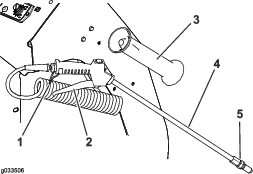
-
Firmly grip the spray wand and point it in the direction that you will spray.
Note: The wand may recoil; ensure that you hold it securely.
-
Adjust the pump pressure to the spray wand perform the following:
-
To increase the pump pressure to the wand, rotate the wand-pressure control counterclockwise (Figure 49).
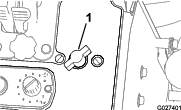
-
To decrease pressure to the wand, rotate the control clockwise direction (Figure 49).
-
To shut off the pressure to the wand, rotate the wand-pressure control clockwise until the valve for the control is closed (Figure 49).
-
-
Squeeze the trigger to the spray-wand handle to begin spraying; lock the trigger in place if desired (Figure 48).
-
When finished spraying, if you locked the trigger of the spray-wand—unlock it, and release the trigger (Figure 48)
-
Rotate the sprayer-wand pressure control clockwise to the OFF position (Figure 49).
-
Insert the wand into the wand holder (Figure 48).
After Operation
After Operation Safety
General Safety
-
Park the machine on a level surface; shut off the engine; engage the parking brake; remove the key; and wait for all movement to stop before leaving the operator’s position.
-
After you finish operating the machine for the day, wash off all chemical residue from the outside of the machine; refer to Chemical Safety.
-
Use full-width ramps for loading the machine into a trailer or truck.
-
Tie the machine down securely to the trailer or truck using straps, chains, cable, or ropes. Both front and rear straps should be directed down and outward from the machine.
-
Shut off the fuel before transporting or storing the machine.
-
Keep all parts of the machine in good working condition and all hardware tightened.
-
Allow the engine to cool before storing the machine in any enclosure.
-
Never store the machine or fuel container where there is an open flame, spark, or pilot light, such as on a water heater or on other appliances.
-
Replace any damaged spray wand components; do not attempt to repair hoses, seals, nozzles, or other wand components.
Cleaning and Lubricating the Spreader
| Maintenance Service Interval | Maintenance Procedure |
|---|---|
| After each use |
|
-
Drive the machine to a designated cleaning area with a level surface.
-
Move the motion-control lever in the NEUTRAL position, shut off the engine, wait for all moving parts to stop, remove key, and engage parking brake.
-
Empty the hopper; refer to Emptying the Spreader.
-
Using a hose to spray the inside and outside of the entire spreader with clean water.
Note: Do not use a power washer to clean the machine. The high-pressure water can force residual-corrosive materials into sprayer-spreader components.
-
Tilt the screen at the bottom of the hopper forward to clean the bottom hopper components (Figure 50).

-
Rotate the hopper screen down.
-
Disconnect the hopper rate-gate cable, place the rate gate dial to a setting lower than the maximum open position, and allow the spreader-sprayer to empty completely; refer to Emptying the Spreader.
-
Connect the hopper rate-gate cable; refer to Connecting the Rate-Gate Linkage.
-
Apply water-displacing lubricant to the components as shown in Figure 51.
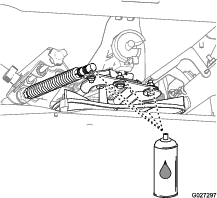
Cleaning the Sprayer
| Maintenance Service Interval | Maintenance Procedure |
|---|---|
| After each use |
|
Warning
Swallowing or inhaling chemicals could cause serious injury or death.
-
Do not clean sprayer nozzles using your mouth or blowing through the nozzles.
-
Replace all worn and damaged sprayer nozzles.
-
Ensure that the nozzles are installed correctly.
Preparing the Machine
-
Empty the sprayer tank; refer to Emptying the Sprayer Tank.
-
Fill the sprayer tank with 19 L (5 US gallons) or more of clean water and install the cap; refer to Filling the Spray Tank.
-
Engage the parking brake, move the steering-control/motion-control lever to the NEUTRAL position, and start the engine (Figure 52); refer to Starting the Engine.

-
Set the sprayer-pump switch to the ON position, and set the engine throttle to FAST position (Figure 52).
-
Move the tank-agitation lever to the ON position (Figure 52).
Cleaning the Sprayer System and Wand
Important: Always empty and clean the sprayer immediately after each use. Failure to do so may cause the chemicals to dry or thicken in the lines, clogging the pump and other components.
-
Pull back both narrow and wide-spray pattern levers to the ON position (Figure 52).
The sprayer nozzles begin spraying.
-
Allow the rinse water in the tank to spray through the nozzles.
-
Check that all 3 nozzles are spraying correctly.
-
Remove the sprayer wand from the holder, point the wand in a safe direction, and squeeze the trigger; refer to Spray-Wand Trigger and Trigger Lock.
Note: Allow the rinse water to discharge from the wand for 1 to 2 minutes.
-
Release the trigger for the wand and return it to the holder on the machine (Figure 7).
-
Move the spray-pattern levers forward to the OFF position, set the sprayer-pump switch to the OFF position, and shut off the engine (Figure 52).
-
Clean the strainer; refer to Cleaning the Strainer.
-
Repeat steps 2 through 7 using cleaners and neutralizers recommended by the chemical manufacturers; refer to Filling the Spray Tank.
-
Repeat steps 2 through 7 using clean water only.
Cleaning the External Components
-
Using a hose to wash off the outside of the sprayer tank with clean water.
Note: Do not use a power washer to clean the machine. The high-pressure water may force residual corrosive materials into spreader-spreader components.
-
Remove and clean the sprayer nozzles; refer to Cleaning the Sprayer Nozzle.
Note: Replace damaged or worn nozzles.
-
Allow the spreader-sprayer to completely dry before the next use.
Cleaning the Strainer
| Maintenance Service Interval | Maintenance Procedure |
|---|---|
| After each use |
|
Important: If you used wettable-powder chemicals, clean the strainer after each time that you rinse the sprayer tank.
-
Empty the sprayer tank; refer to Emptying the Sprayer Tank.
-
Rotate the handle of the pump-shutoff valve 90° counterclockwise to the CLOSE position (Figure 53).

-
Align a drain pan under the strainer (Figure 53).
-
Rotate the strainer bowl counterclockwise and remove the bowl and screen from the body of the strainer (Figure 54).
Note: Remove the strainer bowl by hand.
Note: Replace the gasket or screen or both if these parts are worn or damaged
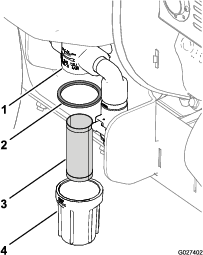
-
Allow any residual chemical solution to drain from the strainer body.
Note: Dispose of the waste solution according to local codes and the chemical manufacturer's instructions.
-
Use a soft-bristle brush and clean water to clean the screen and bowl
-
Install the screen into the strainer body (.Figure 54).
-
Install the gasket and strainer bowl onto the strainer body, and hand tighten the bowl (Figure 54).
-
Rotate the handle of the pump-shutoff valve 90° clockwise to the OPEN position (Figure 53).
Cleaning the Sprayer Nozzle
| Maintenance Service Interval | Maintenance Procedure |
|---|---|
| After each use |
|
-
Rotate the nozzle cap 90° counterclockwise and remove the cap from the nozzle body (Figure 55).
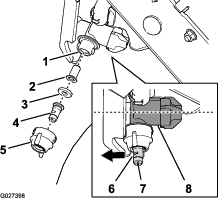
-
Remove the sprayer tip, gasket, and strainer from the nozzle body (Figure 55).
Note: Replace any worn or damaged nozzle parts.
-
Use a soft-bristle brush and clean water to clean the nozzle tip, gasket, and strainer.
-
Assemble the strainer into the nozzle body (Figure 55).
-
Assemble the sprayer tip and gasket into the nozzle cap (Figure 55).
-
Install the tip, gasket, and cap onto the nozzle body (.Figure 55).
Note: Use the slot to rotate the atomizer (Figure 55) of the sprayer tip forward (in-line with the flow-regulator case of the nozzle body).
-
Rotate the nozzle cap 90° clockwise (Figure 55).
-
Repeat steps 1 through 7 for the 2 other sprayer nozzles.
Transporting the Machine
Machine weight: 227 kg (500 lb)—both sprayer tank and hopper empty; 389 kg (857 lb)—both sprayer tank and hopper full
Caution
This machine does not have proper turn signals, lights, reflective markings, or a slow moving vehicle emblem. Driving on a street or roadway without such equipment is dangerous and can lead to accidents causing personal injury. Driving on a street or roadway without such equipment may also be a violation of State laws and the operator may be subject to traffic tickets and/or fines.
Do not drive a machine on a public street or roadway.
Loading the Machine
Warning
Loading a machine onto a trailer or truck increases the possibility of tip-over and could cause serious injury or death.
-
Use extreme caution when operating a machine on a ramp.
-
Back the machine up the ramp and walk it forward down the ramp.
-
Avoid sudden acceleration or deceleration while driving the machine on a ramp as this could cause a loss of control or a tip-over situation.
-
Do not attempt to turn the machine while on the ramp; you may lose control and drive off the side.
-
Use only a single, full-width ramp; do not use individual ramps for each side of the machine.
-
If individual ramps must be used, use enough ramps to create an unbroken ramp surface wider than the machine.
Use a heavy-duty trailer or truck to transport the machine. Ensure that the trailer or truck has all the necessary brakes, lighting, and marking as required by law. Please carefully read all the safety instructions.
-
If using a trailer, connect it to the towing vehicle and connect the safety chains.
-
If applicable, connect the trailer brakes.
-
Lower the ramp.
-
Raise the operator platform.
-
Back the machine up the ramp (Figure 56).

-
Secure the machine; refer to Securing the Machine for Transport.
Securing the Machine for Transport
Note: Refer to the chemical-warning-product label(s) before transporting the machine and follow all local/state/federal requirements for transporting chemicals.
Note: Ensure that the spreader-hopper cover and the spray wand are secure before transporting.
-
At the left side of the machine, ensure that the shutoff valve for the sprayer tank is closed and the drain plug is secure. At the right side of the machine, ensure that the pump-shutoff valve is closed.
-
Shut off the engine, remove the key, and engage the parking brake.
-
Close the fuel valve and block the tires.
-
Use the tie-down points on the machine to securely bind the machine to the trailer or truck with straps, chains, cable, or ropes (Figure 57). Refer to local regulations for trailer and tie-down requirements.
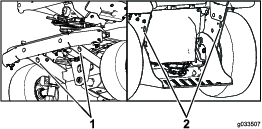
Maintenance
Maintenance Safety
-
While performing maintenance on the machine, someone could start the engine. Accidental starting of the engine could seriously injure you or others. Remove the key from the ignition switch, engage parking brake, and pull the wire(s) off the spark plug(s) before you do any maintenance. Also, push the wire(s) aside so that it does not accidentally contact the spark plug(s).
-
The engine can become very hot. Touching a hot engine can cause severe burns. Allow the engine to cool completely before servicing or repairing around the engine area.
-
Park the machine on level ground and allow it to cool. Never allow untrained personnel to service the machine.
-
Disengage the spray or close the spreader gate, set the parking brake, shut off the engine, and remove the key or disconnect the spark-plug wire. Wait for all movement to stop before adjusting, cleaning, or repairing the machine.
-
Disconnect the battery or remove the spark-plug wire before making any repairs. Disconnect the negative terminal first and the positive terminal last. Connect positive terminal first and negative terminal last.
-
Relieve the pressure from the spray system before servicing the machine.
-
Empty the tank and/or hopper before tilting the machine for maintenance and before storage.
-
Hydraulic fluid escaping under pressure can penetrate skin and cause injury. Fluid accidentally injected into the skin must be surgically removed within a few hours by a doctor familiar with this form of injury; otherwise, gangrene may result.
-
If equipped, ensure that all hydraulic fluid hoses and lines are in good condition and that all hydraulic connections and fittings are tight before applying pressure to the hydraulic system.
-
Keep your body and hands away from pinhole leaks or nozzles that eject high-pressure hydraulic fluid.
-
Use cardboard or paper, not your hands, to find hydraulic leaks.
-
Safely relieve all pressure in the hydraulic system by placing the motion-control levers in neutral and shutting off the engine before working on the hydraulic system.
-
-
Raising the machine for service or maintenance relying solely on mechanical or hydraulic jacks could be dangerous. The mechanical or hydraulic jacks may not be enough support or may malfunction, allowing the machine to fall and cause possible injury. Do not rely solely on mechanical or hydraulic jacks for support. Use adequate jack stands or equivalent support.
-
Carefully release the pressure from components with stored energy.
-
Keep your hands and feet away from moving parts. If possible, do not make adjustments while the engine is running. If the maintenance or adjustment procedure requires the engine to be running and components moving, use extreme caution.
-
Contact with moving parts or hot surfaces may cause personal injury. Keep your fingers, hands, and clothing clear of rotating components and hot surfaces.
-
Check all bolts frequently to maintain their proper tightness.
Recommended Maintenance Schedule(s)
| Maintenance Service Interval | Maintenance Procedure |
|---|---|
| After the first 10 hours |
|
| Before each use or daily |
|
| After each use |
|
| Every 50 hours |
|
| Every 80 hours |
|
| Every 100 hours |
|
| Monthly |
|
| Yearly |
|
| Yearly or before storage |
|
Notation for Areas of Concern
| Inspection performed by: | ||
| Item | Date | Information |
| 1 | ||
| 2 | ||
| 3 | ||
| 4 | ||
| 5 | ||
| 6 | ||
| 7 | ||
| 8 | ||
Important: Refer to your engine owner’s manual for additional maintenance procedures.
Pre-Maintenance Procedures
Caution
If you leave the key in the switch, someone could accidently start the engine and seriously injure you or other bystanders.
Remove the key from the switch before you perform any maintenance.
Caution
Raising the machine for service or maintenance relying solely on mechanical or hydraulic jacks could be dangerous. The mechanical or hydraulic jacks may not be enough support or may malfunction allowing the machine to fall, which could cause injury.
Do not rely solely on mechanical or hydraulic jacks for support. Use adequate jack stands or equivalent support.
Preparing the Machine
Warning
While you are maintaining or adjusting the machine, someone could start the engine. Accidentally starting the engine could seriously injure you or other bystanders.
Remove the key from the ignition, engage parking brake, and pull the wire(s) off the spark plug(s) before you do any maintenance. Also push the wire(s) aside so it does not accidentally contact the spark plug(s).
Perform the following before servicing, cleaning, or making any adjustments to the machine.
-
Park the machine on a level surface.
-
Shut the wide-distribution impeller-gate for the spreader and shut off the sprayer-pump switch.
-
Shut off the engine and remove the key.
-
Engage the parking brake.
-
Wait for all moving parts to stop allow the engine to cool before servicing, storing, or making repairs.
-
Disconnect the spark-plug wire (Figure 58).

Lubrication
Lubricating the Grease Fittings
| Maintenance Service Interval | Maintenance Procedure |
|---|---|
| Every 100 hours |
|
Grease type: National Lubricating Grease Institute (NGLI) grade #2 multi-purpose gun grease.
-
Prepare the machine for maintenance; refer to Preparing the Machine.
-
Wipe the grease fittings clean with a rag (Figure 59).
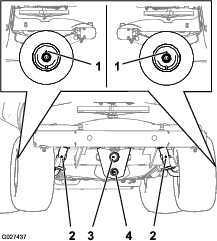
-
Connect a grease gun to the fittings (Figure 59).
-
Pump grease into the fittings until grease begins to come out of the bearings.
-
Wipe up any excess grease.
Engine Maintenance
Servicing the Air Cleaner
| Maintenance Service Interval | Maintenance Procedure |
|---|---|
| Before each use or daily |
|
| Every 100 hours |
|
Important: Do not operate the engine without the air filter assembly; extreme engine damage may occur.
Removing the Foam and Paper Elements
-
Move motion-control lever to the NEUTRAL position, shut off the engine, wait for all moving parts to stop, remove key, and engage parking brake.
-
Release the latches on the cover for the air cleaner.
-
Remove the cover and thoroughly clean it ().
Note: Be careful to prevent dirt and debris from falling into the base.

Cleaning the Foam Filter Element
-
Remove the foam pre-cleaner from the paper element.(Figure 60).
-
Wash the pre-cleaner with warm water and a mild detergent.
-
Rinse the pre-cleaner and allow it to air dry.
-
Lightly oil pre-cleaner with new engine oil; squeeze out excess oil.
Installing the Foam and Paper-Filter Elements
-
Remove and inspect the paper air-filter element (); if the air-filter element is excessively dirty, replace it.
Important: Do not to clean the air-filter element.
-
Wipe clean the air-filter base with a moist rag.
Note: Be careful to prevent dirt and debris from entering the air duct leading to the carburetor.
-
Install the foam pre-cleaner onto the air-filter element (Figure 60).
-
Install the air filter assembly to the air-filter base (Figure 60).
-
Align the arrow decal on the air-cleaner cover and the arrow decal on the base (Figure 61).

-
Secure the air-filter cover to the base with the latches.
Engine Oil Specification
Oil Type: Toro 4-Cycle Premium Engine Oil or a high-quality detergent oil (including synthetic) API service SJ or higher
Oil viscosity: Refer to the table below.

Checking the Engine-Oil Level
| Maintenance Service Interval | Maintenance Procedure |
|---|---|
| Before each use or daily |
|
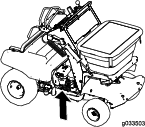
Important: Do not operate the engine with the oil level below the Low (or Add) mark on the dipstick, or over the Full mark.
-
Move the machine to a level surface.
-
Prepare the machine for maintenance; refer to Preparing the Machine.
-
Allow the engine to cool.
-
Remove the dipstick from the engine and wipe the dipstick with a clean rag (Figure 64).
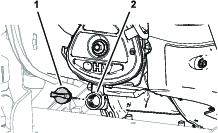
-
Insert the dipstick from the engine as shown in Figure 65.
Note: Do not thread the dipstick into the filler neck when checking the engine oil level.

-
Remove the dipstick from the filler neck and look at the oil level in the dipstick (Figure 65).
Note: The engine oil level must cover the hatch-marked area of the dipstick (Figure 65).
-
If the oil level is low, wipe off the area around the filler neck and add the specified oil until the oil level is between the hatch marked areas on the dipstick.
Important: Do not overfill the engine with oil.
-
Hand tighten the dipstick into the filler neck (Figure 64).
Changing the Engine Oil
| Maintenance Service Interval | Maintenance Procedure |
|---|---|
| After the first 10 hours |
|
| Every 100 hours |
|
Draining the Engine Oil
-
Prepare the machine for maintenance; refer to Preparing the Machine.
-
Shut off the engine, remove the key, and wait for all moving parts to stop before leaving the operating position
-
Align a drain pan with a capacity of 1.5 L (1.6 US qt) or greater below the drain valve at the bottom of the skid plate and inboard from the battery tray (Figure 66).
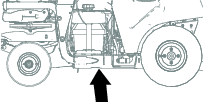
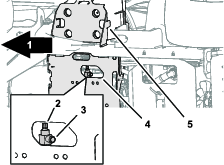
-
Open the drain valve by rotating the hex-head stem of the valve counterclockwise with a wrench (Figure 66).
Note: Allow the engine oil to drain completely.
-
Close the drain valve clockwise until the valve is fully seated (Figure 66).
Note: Wipe clean any residual oil from the drain valve.
Adding Engine Oil to the Engine
Important: Do not operate the engine with the oil level below the Low (or Add) mark on the dipstick, or over the Full mark.
-
Remove the dipstick from the filler neck of the engine and wipe clean the dipstick with a rag (Figure 67).

-
Slowly pour 1.1 L (1.2 US qt) of the specified oil into the crank case of the engine through the filler neck (Figure 67).
-
Insert the dipstick from the engine as shown in Figure 68.
Note: Do not thread the dipstick into the filler neck when checking the engine oil level.

-
Remove the dipstick from the filler neck and look at the oil level in the dipstick (Figure 68).
Note: The engine oil level must cover the hatch-marked area of the dipstick (Figure 68).
-
If the oil level is low, add the specified oil into the engine until the oil level is between the hatch marked areas on the dipstick.
Note: Do not overfill the engine with oil.
-
Hand tighten the dipstick into the filler neck (Figure 67).
Servicing the Spark Plug
Spark Plug Specification
Spark plug type: Champion® RC12YC, Kohler® 12 132 02-S, or Kohler 25 132 14-S (RFI compliant)
Removing the Spark Plug
-
Prepare the machine for maintenance; refer to Preparing the Machine.
-
Remove the spark plug as shown in Figure 69.
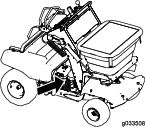
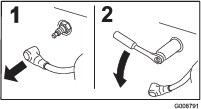
Checking the Spark Plug
Spark-plug gap: 0.76 mm (0.030 inch)
Important: Do not clean the spark plug(s). Always replace the spark plug(s) when it has a black coating, worn electrodes, an oily film, or cracks.
If you see light brown or gray on the insulator, the engine is operating properly. A black coating on the insulator usually means the air cleaner is dirty.
Use a gapping tool/feeler gauge to check and adjust the air gap to 0.76 mm (0.030 inch).
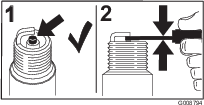
Installing the Spark Plug
Tighten the spark plug as follows:
-
New spark plug—12 to 15 N∙m (8.7 to 10.8 ft-lb)
-
In-service spark plug—23 to 27 N∙m (16.6 to 19.5 ft-lb)
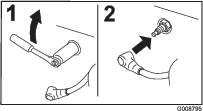
Cleaning the Spark Arrester
Required parts: muffler gasket; refer to the parts catalog for your engine.
-
Remove the 2 flange bolts that secure the muffler to the exhaust-outlet flange of the engine, and remove the muffler (Figure 72).
Note: Discard the old muffler gasket.

-
Remove the screws that secure the heat shield to the muffler, and remove the heat shield (Figure 73).
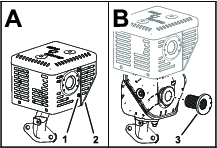
-
Remove the spark arrester screen and clean it (Figure 73).
-
Assemble the spark arrester screen to the muffler (Figure 73).
-
Assemble the heat shield to the muffler with the screws that you removed in step 2.
-
Align the muffler and a new exhaust gasket to the exhaust-outlet flange of the engine (Figure 72).
-
Assemble the muffler and gasket to the engine with the 2 flange-head bolts that you removed in step 1.
-
Torque the flange-head bolts to 35 N∙m (310 in-lb).
Fuel System Maintenance
Draining the Fuel System
-
Close the fuel-shutoff valve; refer to Opening and Closing the Fuel Shutoff Valve.
-
Locate the drain bolt that is in the side port of the carburetor bowl (Figure 74).
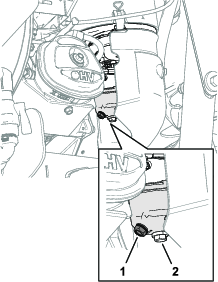
-
Align the equipment that you will use to collect the fuel beneath the drain screw.
-
Remove the drain screw from the carburetor and allow the fuel to drain from the fuel tank and the carburetor.
Note: Do not remove the bowl-retaining screw from carburetor.
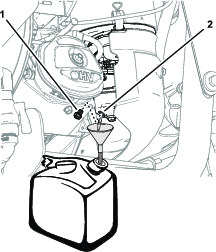
-
Install the drain bolt into the side port of the carburetor.
-
Open the fuel shutoff valve and check for leaks.
Note: Repair all fuel leaks before operating the engine.
Electrical System Maintenance
Servicing the Battery
| Maintenance Service Interval | Maintenance Procedure |
|---|---|
| Monthly |
|
Always keep the battery clean and fully charged. Use a paper towel to clean the battery case. If the battery terminals are corroded, clean them with a solution of four parts water and one part baking soda. Apply a light coating of grease to the battery terminals to prevent corrosion.
Voltage: 12 V
Danger
Charging or jump starting the battery may produce explosive gases. Battery gases can explode causing serious injury.
-
Keep sparks, flames, or cigarettes away from battery.
-
Ventilate when charging or using battery in an enclosed space.
-
Ensure that the venting path of battery is always open once the battery is filled with acid.
-
Do not lean over the batteries.
-
Always shield eyes and face from battery.
Danger
Battery electrolyte contains sulfuric acid, which is poisonous and can cause severe burns. Swallowing electrolyte can be fatal or if it touches skin can cause severe burns.
-
Wear eye protection to shield your eyes and rubber gloves to protect your skin and clothing when handling electrolyte.
-
Do not swallow electrolyte.
-
In the event of an accident, flush with water and call a doctor immediately.
Checking the Battery Charge
Caution
If the ignition is in the ON position, there is potential for sparks and engagement of components. Sparks could cause an explosion or moving parts could accidentally engage causing personal injury.
Be sure ignition switch is in the OFF position before charging the battery.
-
Prepare the machine for maintenance; refer to Preparing the Machine.
-
Remove the free end of the battery strap from the buckle and remove the battery cover from the battery box (Figure 76).

-
Measure the voltage of the battery with a voltmeter.
-
Use the table below to locate the charge state or the battery, and if needed, the battery-charger setting and charging interval recommended to charge the battery to 12.6 V or greater; refer to the battery charge table below.
Important: Ensure that the negative battery cable is disconnected, and the battery charger used for charging the battery has an output of 16 V and 7 A or less to avoid damaging the battery (see chart for recommended charger settings).
Battery Charge Table
Voltage Reading Percent Charge Maximum Charger Settings Charging Interval 12.6 or greater 100% 16 V/7 A No Charging Required 12.4 – 12.6 75–100% 16 V/7 A 30 Minutes 12.2 – 12.4 50–75% 16 V/7 A 1 Hour 12.0–12.2 25–50% 14.4 V/4 A 2 Hours 11.7–12.0 0–25% 14.4 V/4 A 3 Hours 11.7 or less 0% 14.4 V/2 A 6 Hours or More -
If the positive cable is also disconnected, connect the positive (red) cable to the positive-battery terminal and slip terminal cover over the positive terminal (Figure 76).
-
Remove the screw, washer, and ground cable from the engine. Secure the battery cable to the battery terminal with the bolt, washer, and nut and torque the nut and bolt to 1978 to 2542 N∙cm (175 to 225 in-lb).
Note: If time does not permit charging the battery or if charging equipment is not available, connect the negative-battery cables and run the vehicle continuously for 20 to 30 minutes to charge the battery.
-
Align the battery cover to the battery box and secure the cover and box to the battery tray with the battery strap (Figure 76).
Charging the Battery
Warning
Charging the battery produces gasses that can explode.
Never smoke near the battery and keep sparks and flames away from battery.
Important: Always keep the battery fully charged (1.265 specific gravity) to prevent battery damage when the temperature is below 32°F (0°C).
-
Remove the battery from the chassis; refer to Removing the Battery.
-
Check the electrolyte level.
-
Ensure that the filler caps are installed on the battery.
-
Charge the battery for 1 hour at 25 to 30 A or 6 hours at 4 to 6 A.
-
When the battery is fully charged, unplug the charger from the electrical outlet, and disconnect the charger leads from the battery posts (Figure 77).
-
Install the battery onto the machine and connect the battery cables; refer to Installing the Battery.
Note: Do not run the machine with the battery disconnected; electrical damage may occur.
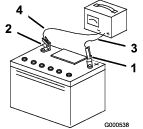
Removing and Installing the Battery
Removing the Battery
Warning
Battery terminals or metal tools could short against metal machine components causing sparks. Sparks can cause the battery gasses to explode, resulting in personal injury.
-
When removing or installing the battery, do not allow the battery terminals to touch any metal parts of the machine.
-
Do not allow metal tools to short between the battery terminals and metal parts of the machine.
Warning
Incorrect battery-cable routing could damage the machine and cables causing sparks. Sparks can cause the battery gasses to explode, resulting in personal injury.
-
Always disconnect the negative-battery cable (black) before disconnecting the positive (red) cable.
-
Always connect the positive-battery cable (red) before connecting the negative (black) cable.
-
Prepare the machine for maintenance; refer to Preparing the Machine.
-
Remove the battery cover (Figure 76); refer to step 2 of Checking the Battery Charge.
-
Remove the hex-flanged bolt and flanged nut from the negative-battery cable and negative (-) battery terminal, and remove the cable from the battery (Figure 78).
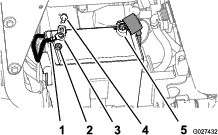
-
Slide the red-terminal cover off the positive-battery terminal (Figure 78).
-
Remove the hex-flanged bolt and flanged nut from the positive (red) battery cable and the positive (+) battery terminal, and remove the cable from the battery (Figure 78).
-
Remove the battery and battery box from the battery tray of the machine.
Installing the Battery
-
Place the battery into the battery box.
-
Position the battery and battery box onto the battery tray of the machine.
-
Install the positive (red) battery cable to positive (+) battery terminal with a flanged bolt and flanged nut (Figure 78).
-
Slide the red terminal cover over the positive-battery terminal.
-
Install the negative battery cable to the negative (-) battery terminal with a flanged bolt and flanged nut (Figure 78).
-
Align the battery cover to the battery box and secure the cover and box to the battery tray with the battery strap (Figure 76)
Jump-Starting the Machine
Danger
Jump-starting a battery that is cracked, frozen, has low electrolyte level, or an open/shorted battery cell, can cause an explosion resulting in serious personal injury.
Do not jump-start a battery if these conditions exist; replace the battery.
Caution
Corrosion or loose connections can cause unwanted electrical voltage spikes at any time during the jump-starting procedure.
Do not attempt to jump start a machine with loose or corroded battery terminals, or damage to the engine can occur.
Caution
Connecting the jumper cables incorrectly (wrong polarity) can immediately damage the electrical system.
Be certain of the battery-terminal polarity and the jumper-cable polarity when connecting to the battery.
Important: Be sure that the vehicles do not touch and that both electrical systems are off and at the same rated system voltage. These instructions are for negative-ground systems only.
Important: Use the properly sized jumper cables (4 to 6 AWG) with short lengths to reduce the voltage drop between systems. Ensure that the cables are color coded or labeled for the correct polarity.
Note: The following instructions are adapted from the SAE J1494 Rev. Dec. 2001 – Battery Booster Cables – Surface Vehicle Recommended Practice (SAE – Society of Automotive Engineers).
-
Check the battery terminals of the discharged battery and the booster battery for corrosion (white, green, or blue “snow”).
Note: Clean the corrosion from the battery terminals prior to jump starting. Tighten the battery cable connections as necessary.
-
Ensure that the booster is a 12-volt battery with a sufficient amp rating that is in good condition and fully charged.
Note: Ensure that the vent caps are tight and level. If available, place a damp cloth over any vent caps on both batteries.
-
Connect the positive (+) cable clamp (red) to the positive (+) terminal of the discharged battery ().
Note: The positive-battery cable is wired to the starter or solenoid.

-
Connect the other positive (+) cable clamp (red) to the positive terminal of the booster battery.
-
Connect the negative (–) cable clamp (black) to the negative terminal of the booster battery.
-
Connect the other negative (–) cable clamp (black) to the engine block of the stalled machine and away from the discharged battery.
Important: Do not connect the negative (–) cable clamp (black) to the negative battery post of the discharged battery.
-
Stand away from the discharged battery of the machine.
-
Start the machine and remove the cables in the reverse order of connection, disconnect the engine block connection first.
Servicing the Fuses
The electrical system is protected by fuses, and requires no maintenance. If a fuse blows, check the component or circuit for a malfunction or short.
-
Remove the negative-battery cable from the battery terminal; refer to steps 2 and 3 of Removing the Battery.
Note: Ensure that the negative battery cable does not touch the battery terminal.
-
Push the tab on the fuse/relay holder and separate the cover from the holder (Figure 80).
-
Pull the fuse from the socket of the fuse/relay holder (Figure 80).
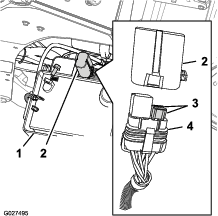
-
Install a fuse of the same type (20 A) into the socket of the fuse/relay holder (Figure 80).
-
Install the cover on to the fuse/relay holder until it locks into place (Figure 80).
-
Install the negative-battery cable from the battery terminal; refer to steps 5 and 6 of Installing the Battery.
Drive System Maintenance
Checking the Air Pressure in the Tires
| Maintenance Service Interval | Maintenance Procedure |
|---|---|
| Every 50 hours |
|
Note: Service the air pressure in both the front and rear tires.
-
Prepare the machine for maintenance; refer to Preparing the Machine.
-
Check tire pressure in front and rear tires.
-
If necessary, adjust the air pressure in the tires to 83 to 97 kPa (12 to 14 psi).
Torqueing the Axle Bolts
| Maintenance Service Interval | Maintenance Procedure |
|---|---|
| Yearly |
|
-
Torque the 4 axle bolts on both front and rear wheels (Figure 81) to 48 N∙m (35 ft-lb).
-
Torque the 2 setscrews on each rear wheel to 12 N∙m (105 in-lb).
Important: If you remove the wheel(s) for maintenance, apply medium-grade thread-locking compound to the threads of the bolts before installing the wheel(s)
Important: If you remove the rear wheel(s) for maintenance apply a copper-based, anti-seizing compound on the rear-axle shafts.
Important: Do not use anti-seize compound on the wheel bolts.
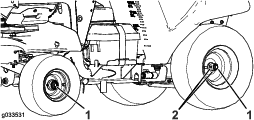
Aligning the Front Wheels
Operator supplied equipment: 2 bolts 9 x 76 mm (5/16 x 3 inch) or longer
-
Prepare the machine for maintenance; refer to Preparing the Machine.
-
Check the tire pressure; refer to Checking the Air Pressure in the Tires.
-
Center and secure the steering control by aligning 2 bolts (5/16 x 3 inch) through the outside holes on the steering control and through the control column.
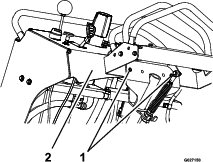
-
Measure the distance between the 2 front faces of the front tires as shown in Figure 83.
Record the front measurement here .
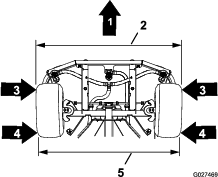
-
Measure the distance between the 2 rear faces of the front tires as shown in Figure 83.
Record the front measurement here .
Note: The front measurement should be 6.4 to 12.7 mm (1/4 to 1/2 inch) larger than the rear measurement.
-
If the front measurement is smaller than 6.4 mm (1/4 inch) or larger than 12.7 mm (1/2 inch), adjustment the rod ends for the steering linkage as follows:
-
Remove the 4 thumb screws that secure the front cover (below the impeller) to the chassis and remove the cover (Figure 84).

-
Loosen the jam nuts at the rod ends.
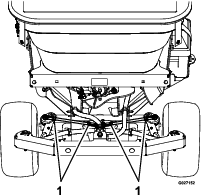
-
Rotate the steering rod to lengthen or shorten the linkage. Adjust both the left and right steering linkages equally.
Note: The factory center-to-center distance between the ball-joint rod ends at the steering linkage is 23.3 cm (9.21 inches).
-
Tighten the jam nuts.
-
Align the holes in the front cover with the clip nuts in the chassis and secure the cover with the 4 thumb nuts that you removed in 1.
-
-
Remove the bolts that you installed in step 3 from the control column and steering control.
Servicing the Transaxle
| Maintenance Service Interval | Maintenance Procedure |
|---|---|
| Every 50 hours |
|
Transaxle Oil Type: Toro® HYPR-OIL™ 500 hydraulic oil or Mobil® 1 15W-50
-
Prepare the machine for maintenance; refer to Preparing the Machine.
-
Rotate counterclockwise the 2 quarter-turn fasteners that secure the knee pad to the chassis of the machine (Figure 86).
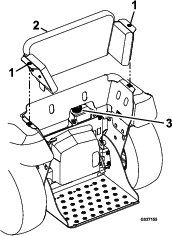
-
Lift the knee pad up and rearward slightly and remove the pad from the machine (Figure 86).
-
Clean area around fluid-expansion tank and remove cap (Figure 86).
-
Check the fluid level in the expansion tank.
Note: The fluid-level cover the bottom port in tank
-
If the fluid level is too low, add the specified fluid into the expansion tank.
-
Install the tank cap onto the expansion tank and tighten the cap until it is snug (Figure 86).
Note: Do not overtighten the cap.
Controls System Maintenance
Adjusting the Pattern Control Cable for the Spreader
-
Prepare the machine for maintenance; refer to Preparing the Machine.
-
Empty the hopper; refer to Emptying the Spreader
-
Close the impeller gate by pushing the wide-distribution impeller-gate lever forward fully (Figure 87).
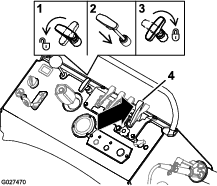
-
Rotate the spread-pattern-control handle counterclockwise, push the handle down, and rotate the spread-pattern-control handle clockwise(3) refer to Figure 87.
-
Loosen the jam nut at the end of the pattern-control cable (Figure 88).
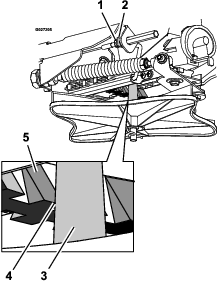
-
Pull the linkage rod until there is 1/8 inch (3.2 mm) gap between the ramp tooth and the impeller shaft (Figure 88).
-
Tighten the jam nut (Figure 88).
-
Adjust the spread-pattern-control handle; refer to Adjusting the Spreader Pattern.
Maintaining the Chassis
Checking the Machine for Loose Hardware
| Maintenance Service Interval | Maintenance Procedure |
|---|---|
| Before each use or daily |
|
-
Prepare the machine for maintenance; refer to Preparing the Machine.
-
Visually inspect machine for damaged or worn parts, and check for loose hardware.
Note: Before operating the machine, replace any damaged parts and tighten all loose hardware.
Maintaining the Sprayer System
Checking Sprayer System
| Maintenance Service Interval | Maintenance Procedure |
|---|---|
| Every 50 hours |
|
-
Prepare the machine for maintenance; refer to Preparing the Machine.
-
Check all hoses, nozzles, and fittings for damage and leaks.
Note: Replace all damaged or leaking sprayer components.
-
Check the nozzle strainers and in-line strainers for accumulation of dirt and chemical sludge.
Note: Clean or replace strainers with an accumulation of dirt and chemical sludge.
Cleaning
Cleaning the Engine and the Exhaust System Area
| Maintenance Service Interval | Maintenance Procedure |
|---|---|
| After each use |
|
Caution
Excessive debris around engine-air intake and exhaust system area can cause engine, exhaust area, and hydraulic system to overheat which can create a fire hazard.
Clean all debris from engine and exhaust system area.
-
Prepare the machine for maintenance; refer to Preparing the Machine.
-
Clean all debris from screen next to the starter grip of the engine, around engine shrouding, fuel tank, and exhaust system area.
-
Wipe up any excessive grease or oil around the engine and exhaust system area.
-
Clean muffler-heat shields of all debris, dirt, and oil.
Cleaning the Debris from the Machine
| Maintenance Service Interval | Maintenance Procedure |
|---|---|
| After each use |
|
-
Prepare the machine for maintenance; refer to Preparing the Machine.
-
Clean off any debris or chemical build-up on the machine, especially the nozzles, sprayer-tank opening, impeller, and the spray wand and its holder
Removing the Engine Shroud and Cleaning the Cooling Fins
| Maintenance Service Interval | Maintenance Procedure |
|---|---|
| Every 80 hours |
|
-
Prepare the machine for maintenance; refer to Preparing the Machine.
-
Remove cooling shroud from engine.
-
Clean cooling fins of the engine.
Note: Also, clean dust, dirt, and oil from external surfaces of engine which can cause improper cooling.
-
Install the cooling shrouds onto the engine.
Note: Operating the engine without cooling shrouds will cause engine damage due to overheating.
Waste Disposal
Chemical Disposal
Improper chemical disposal can pollute the environment and cause health issues.
Follow the disposal directions on the chemical-manufacturer’s label. Dispose of chemicals and containers in accordance to local/state/federal laws.
Disposing of the Engine Oil
Engine oil and hydraulic fluid are both pollutants to the environment. Dispose of used pollutants at a certified-recycling center or according to your state and local regulations.
Disposing of the Battery
Danger
Battery electrolyte contains sulfuric acid, which is poisonous and can cause severe burns. Swallowing electrolyte can be fatal or if it touches skin can cause severe burns.
-
Wear eye protection to shield eyes, and rubber gloves to protect skin and clothing when handling electrolyte.
-
Do not swallow electrolyte.
-
In the event of an accident, flush with water and call a doctor immediately.
Federal law states that batteries should not be placed in the garbage. Management and disposal practices for batteries must follow relevant federal, state, or local laws.
Take the battery to a local certified-recycling center if you replace a worn or damaged battery or if the machine no longer operates and is being scrapped.
Note: If no local recycling is available, return the battery to any certified battery seller.
Storage
-
Set sprayer-pump switch to the OFF position, stop the machine, move motion-control lever to the NEUTRAL position, shut off the engine, wait for all moving parts to stop, remove key, and engage parking brake.
-
Remove dirt and grime from the entire machine.
Important: You can wash the machine with mild detergent and water. Do not pressure wash the machine. Avoid excessive use of water, especially near the engine and hydrostatic drive.
-
Service the air cleaner; refer to Servicing the Air Cleaner.
-
Lubricate the machine; refer to Lubricating the Grease Fittings.
-
Change the engine oil; refer to Changing the Engine Oil.
-
Remove the rear wheels, apply a copper-based, anti-seizing compound to the rear-axle shafts, and install the wheels; refer to Torqueing the Axle Bolts.
-
Check and tighten all bolts, nuts, and screws. Repair or replace any part that is damaged.
-
Paint all scratched or bare metal surfaces. Paint is available from your Authorized Service Dealer.
-
Store the machine in a clean, dry garage or storage area.
-
Cover the machine to protect it and keep it clean.
Preparing the Machine for Extended or Winter Storage
To help protect the pumps from freezing temperatures, ensure that the machine is free of all caustic chemicals and residue.
Cleaning the Spreader
Perform all the steps in Cleaning and Lubricating the Spreader.
Winterizing the Sprayer
Emptying the Tank
-
Perform all the steps in Cleaning the Sprayer System and Wand, Cleaning the Strainer, and Cleaning the Sprayer Nozzle.
-
Empty the sprayer system by performing the following:
-
Empty the sprayer tank; refer to Emptying the Sprayer Tank.
-
Start the machine and set sprayer-pump switch to the ON position
-
Push forward the tank agitation lever.
-
Pull back the narrow-spray pattern lever.
Note: Run the sprayer nozzle until the narrow nozzle is spraying air.
-
Push forward the narrow-spray pattern lever and pull back the wide-spray pattern lever.
Note: Run the sprayer nozzles until the both wide nozzles are spraying air.
-
Push forward the wide-spray pattern lever.
-
-
Shut off the sprayer pump and the engine.
Preparing the Sprayer System
Antifreeze type: 2.5 L (0.7 US gallon) rust inhibiting, non-alcohol based, RV-antifreeze concentrate
Important: Do not allow all the antifreeze mixture to empty from the sprayer tank while running the sprayer nozzles and wand. Keeping some of the antifreeze in the pump, valves, and hoses will help prevent corrosion and damage caused by moist air trapped in the sprayer system.
-
Mix 2.5 L (0.7 US gallon) RV anti-freeze concentrate with 5.1 L (1.3 US gallon) water and pour the antifreeze mixture into the into the sprayer tank.
Note: Use a rust inhibiting, non-alcohol based, RV antifreeze concentrate.
-
Start the machine and set the sprayer-pump switch to the ON position.
-
Pull back the narrow-spray pattern lever to the ON position.
Note: Allow the antifreeze to circulate through sprayer and nozzle.
-
Push forward the narrow-spray pattern lever and pull back the wide-spray pattern lever.
Note: Allow the antifreeze to circulate through sprayer and nozzle.
-
Push forward the wide-spray pattern lever.
-
Remove the wand from its holder, point it in a safe direction, and squeeze the spray-wand trigger.
Note: Allow the antifreeze to circulate through sprayer and nozzle and then return the wand to its holder.
-
Set the sprayer-pump switch to the OFF position and shut off the engine.
Troubleshooting
Important: Ensure that the operator safety mechanisms for the machine are connected and in proper operating condition before you use the machine.
When a problem occurs, do not overlook the simple causes. For example: starting problems could be caused by an empty fuel tank.
The following table lists some of the common causes of trouble. Do not attempt to service or replace major engine items or any items that call for special timing of adjustments procedures (such as valves, governor, etc.). Have this work done by your engine service dealer.
Note: When disconnecting electrical connectors, do not pull on the wires to separate the connectors.
| Problem | Possible Cause | Corrective Action |
|---|---|---|
| The starter does not rotate the engine. |
|
|
| The engine does not start, it starts hard, or it fails to keep running. |
|
|
| The engine loses power. |
|
|
| The engine overheats. |
|
|
| The machine pulls to the left or the right (with steering control fully forward). |
|
|
| The machine does not drive. |
|
|
| The machine vibrates abnormally. |
|
|
| The impeller does not rotate. |
|
|
| The spreader or sprayer pattern is uneven. |
|
|
| There is no spray from the sprayer nozzles in the boom or the nozzles have poor output. |
|
|
| No material dispensed from hopper. |
|
|
| The spray wand does not work. |
|
|
| The indicator light above the impeller On/Off switch is illuminated or flashing. |
|
|
| The indicator light above the sprayer switch is illuminated or flashing. |
|
|
Schematics
Electrical Schematic—135-4709
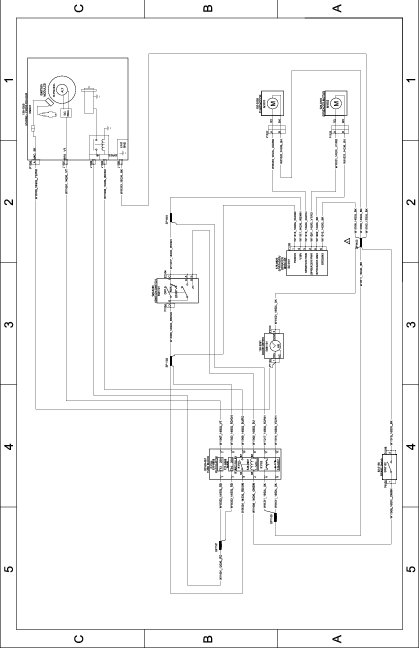
Sprayer System Schematic
